THE FORGOTTEN PRINCESS
The Coffin of Princess Sopdet-em-haawt
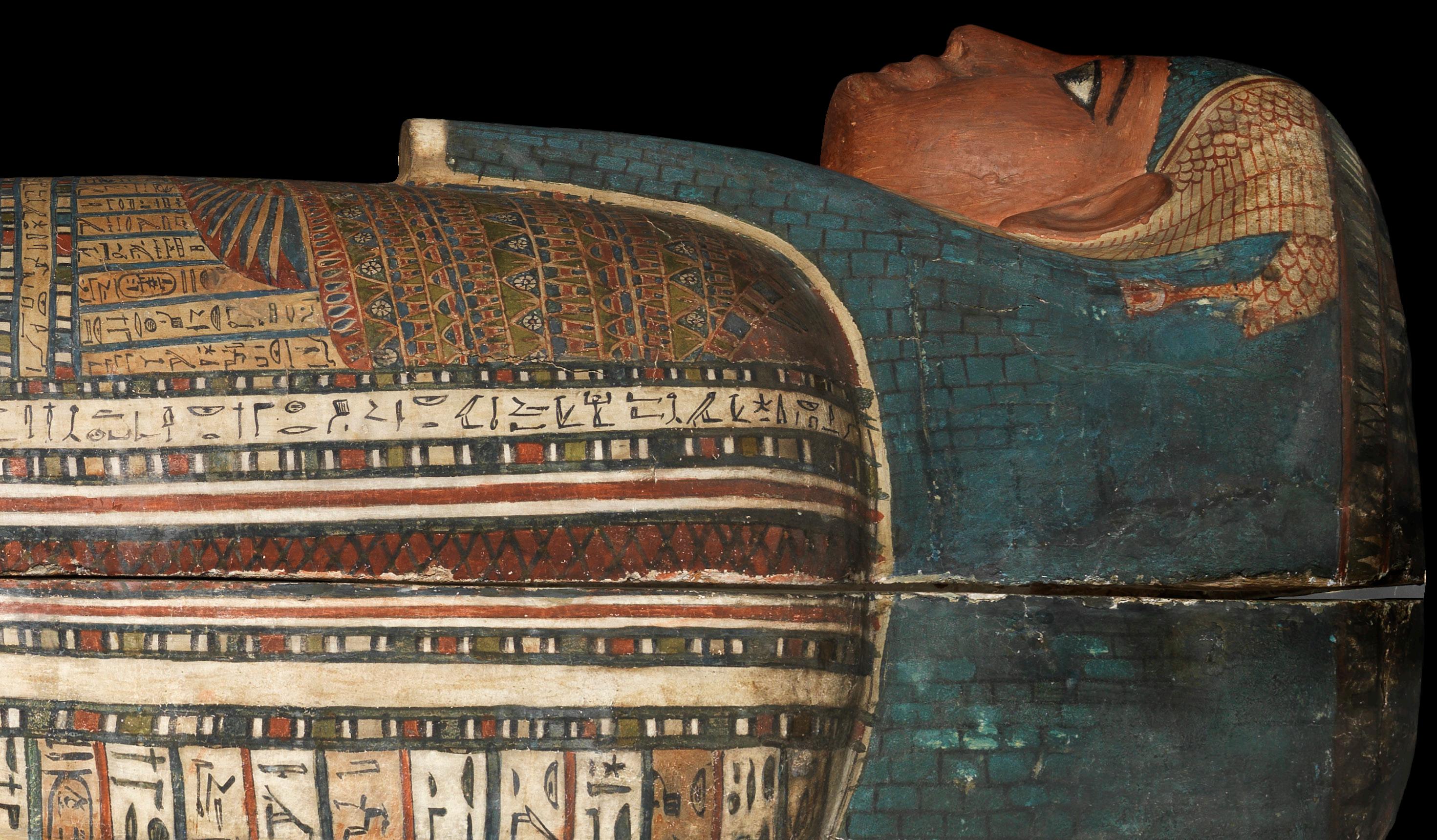

The Coffin of Princess Sopdet-em-haawt

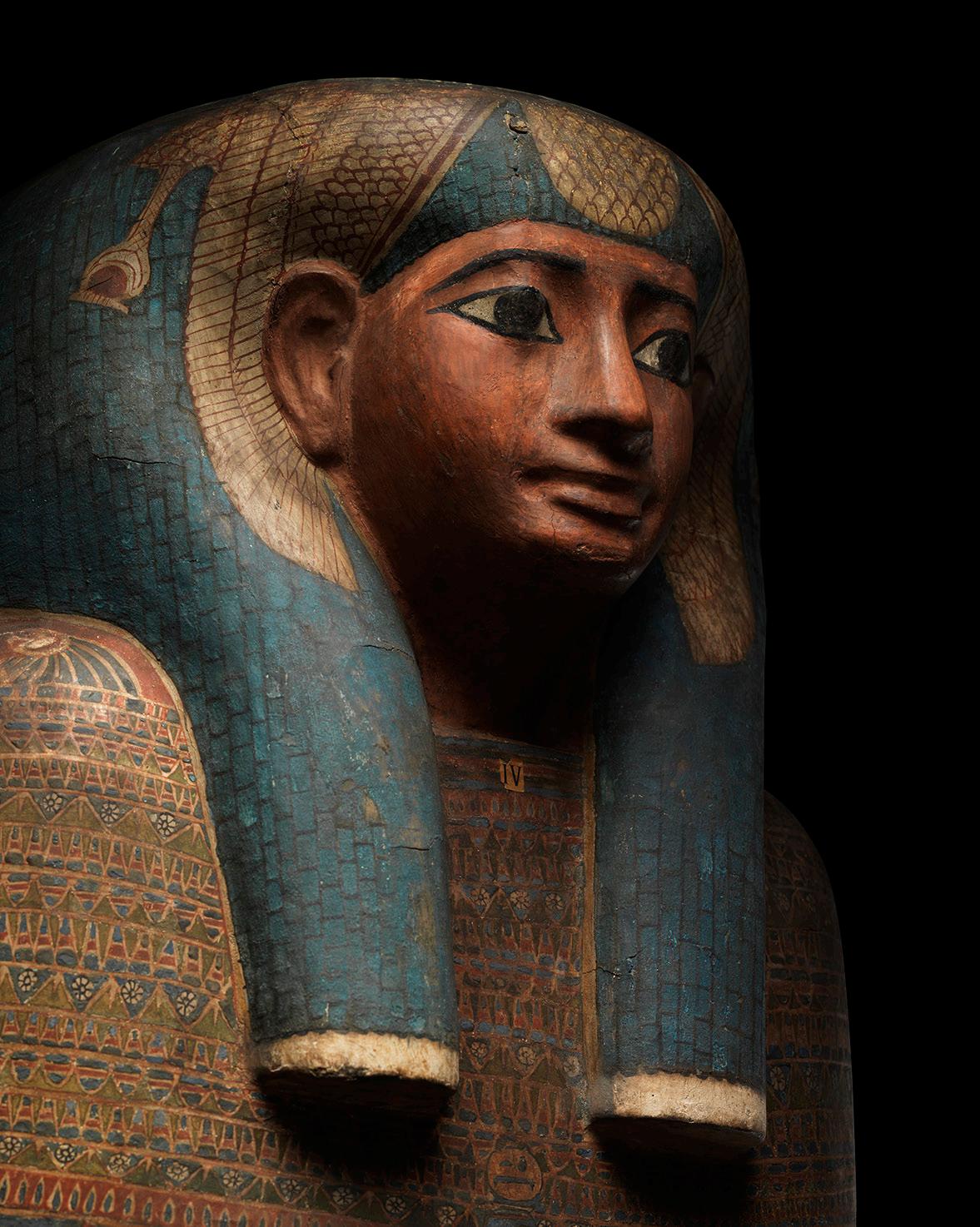
LONDON | 2025
The Coffin of Princess Sopdet-em-haawt
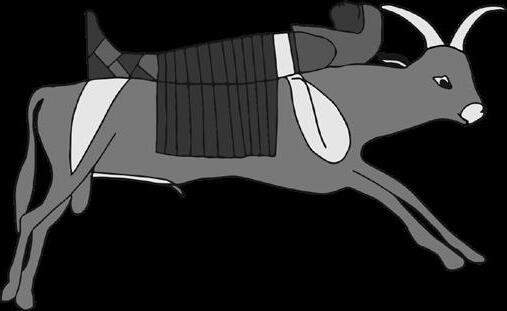


“...where
time slumbers on painted wood, every curve of the coffin speaks of reverence for the eternal soul, as if the colours themselves were borrowed from the heavens to safeguard the royal journey beyond the stars.”
The Coffin of Princess
Sold at Sotheby’s New York in 2013 with a limited provenance. It was not until a year later that conservators gently pried open the coffin for the first time in nearly 200 years, uncovering the golden-rayed, fully inscribed interior and a handwritten note from c.1834 documenting valuable, previously lost information...
The ‘Forgotten Princess’, discovered in 1832 and documented by renowned early archaeologist Robert Hay in his field notebook which is now kept in the British Museum. The coffin of Sopdetem-haawt is both exceptionally decorated and beautifully preserved, it is the only royal coffin ever to be offered for sale on the art market.

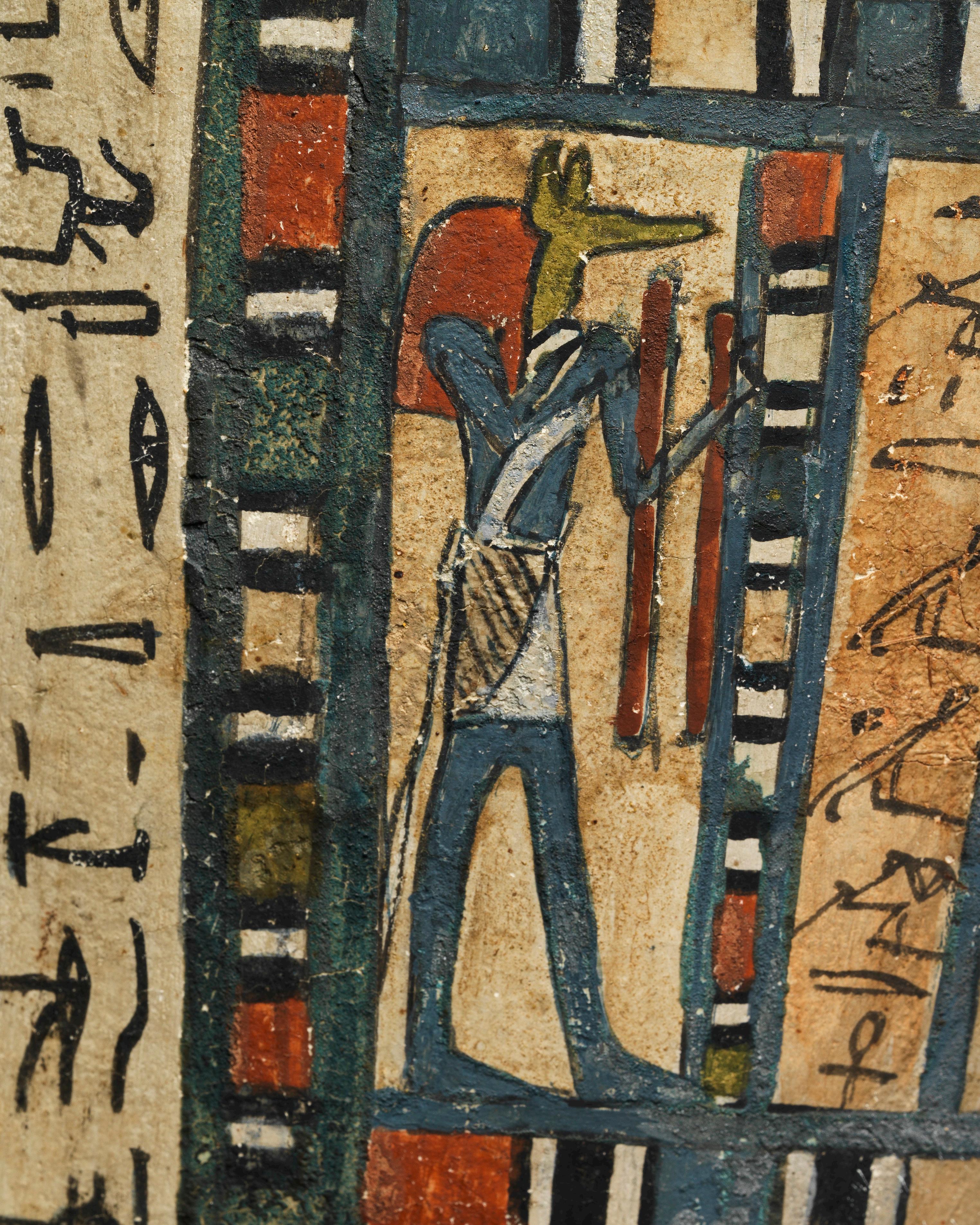
The Coffin of Princess Sopdet-em-haawt
Brief description
Exploration into the Historical Context of Princess Sopdet-em-haawt
Family Tree of Princess Sopdet-em-haawt
Royal Theban Women of the 25th and 26th Dynasties with Royal Libyan Descent
Egyptian Burials and the Role of the Coffin Function of the Coffin and Coffin Materials
Coffin Burial Sets
Egyptian Tombs and 25th and 26th Dynasty Tombs
The Decoration of the Coffin of Sopdet-em-haawt
The Decoration of 25th and 26th Dynasty Coffins
Provenance
Provenance in Full
The Initial Discovery
The Rediscovery
Raphaële Meffre: Translating The Coffin Texts
Notes on the Provenance
Robert Hay
Jules Xavier Saguez de Breuvery De Breuvery and de Cadalvène’s Travels through Egypt and Nubia
Other Known 25th and 26th Dynasty Wooden Painted Coffins
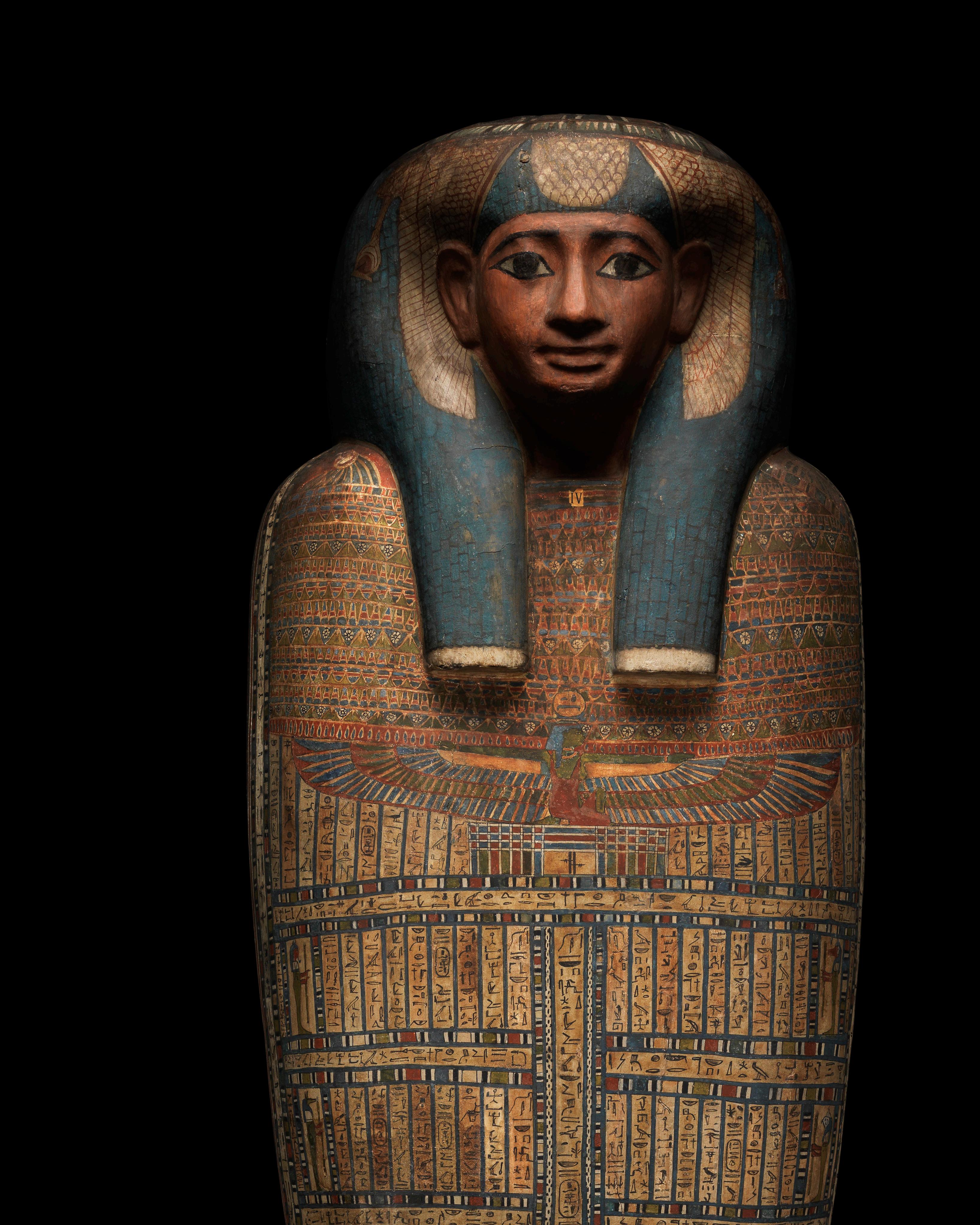

Late 25th-Early 26th Dynasty, 7th century B.C., Egypt
Wood, Polychrome Height: 186.69 cm
Originating from Heracleopolis Magna, Egypt, probably from the Theban necropolis at Sheikh Abd-el Qurna.
Discovered in 1832, according to handwritten note inside the coffin, and recorded by Robert Hay (1799-1863) in a notebook between 1832 and 1834, under the heading ‘Inscriptions on a Mummy Case’, British Library, London, Add.MSS.29827, fol. 83 verso.
Private Collection of Jules Xavier Saguez de Breuvery (1805-1876), Saint-Germain-en-Laye and brought from Egypt to France in 1834, according to handwritten note inside the coffin.
Private Collection of Monsieur Maffre de Baugé, Sète, acquired in the 1970s or earlier.
Thence by descent to his daughter, Mademoiselle Cendrine Maffre de Baugé, France.
Sold at: Egyptian, Classical & Western Asiatic Antiquities, Sotheby’s, New York, 12 December 2013, Lot 15.
Private American Collection, acquired from the above sale. The sarcophagus was opened in 2014, and details of its discovery in Sakara 1832 and acquisition by Jules Xavier Saguez de Breuvery and exportation from Egypt in 1834 were exposed in a handwritten note on the interior.
With David Aaron Ltd., London, acquired from the above in 2017.
ALR: S00218852, with IADAA Certificate, this item has been checked against the Interpol database.
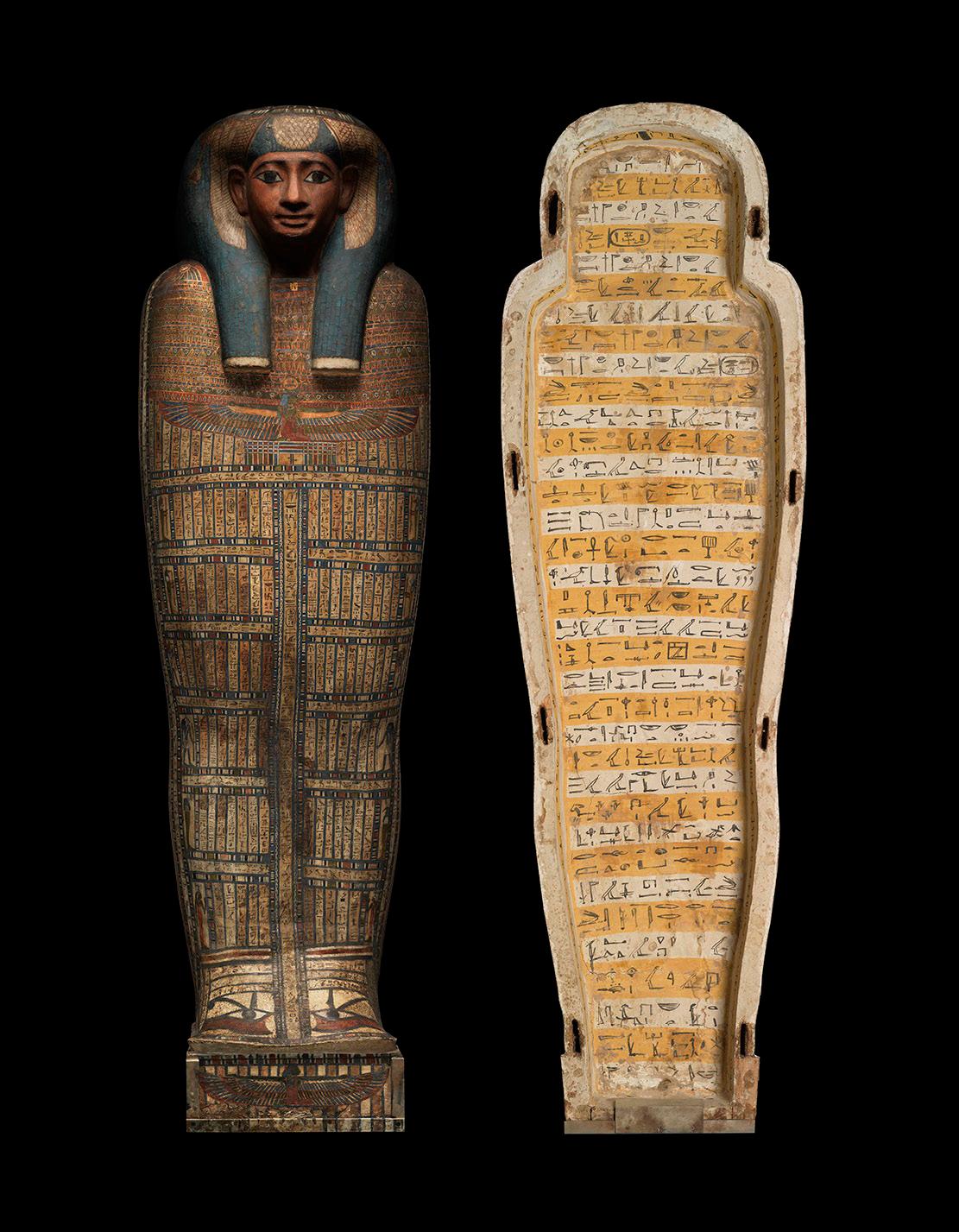
A beautifully crafted wooden polychrome coffin for Princess Sopdetem-haawt, Granddaughter of King Rudamun, ruler of Thebes and Upper Egypt, and daughter of Per-jauawybast, Libyan King of Nennesut (Heracleopolis Magna).
The finely carved face has full lips rounded at the corners, wide-set almond-shaped eyes, and slender tapering eyebrows. The head is topped with a voluminous tripartite wig of echeloned rectangular curls surmounted by a vulture headdress. It is painted with light red skin and black-lined eyes and eyebrows. The neck and shoulders are ornamented with a wide wesekh-collar held by two falcon-headed clasps on the shoulders.
Apotropaic symbols are painted across the coffin, such as the inverted wedjat-eyes on the feet, and a galloping Apis bull carrying a mummy on its back on the underside of the base. The winged sky goddess Nut appears below the collar and again on the front base of the feet.
Below Nut’s outspread wings on the torso, the text names the owner of the coffin and gives a version of the 'Nut formula', known from the times of the Pyramid Texts, which assures that Nut will protect the deceased in the netherworld. Further texts follow in rows of short, closely packed columns on either side of an extended axial column. This arrangement recalls the outer bandages of a mummy.

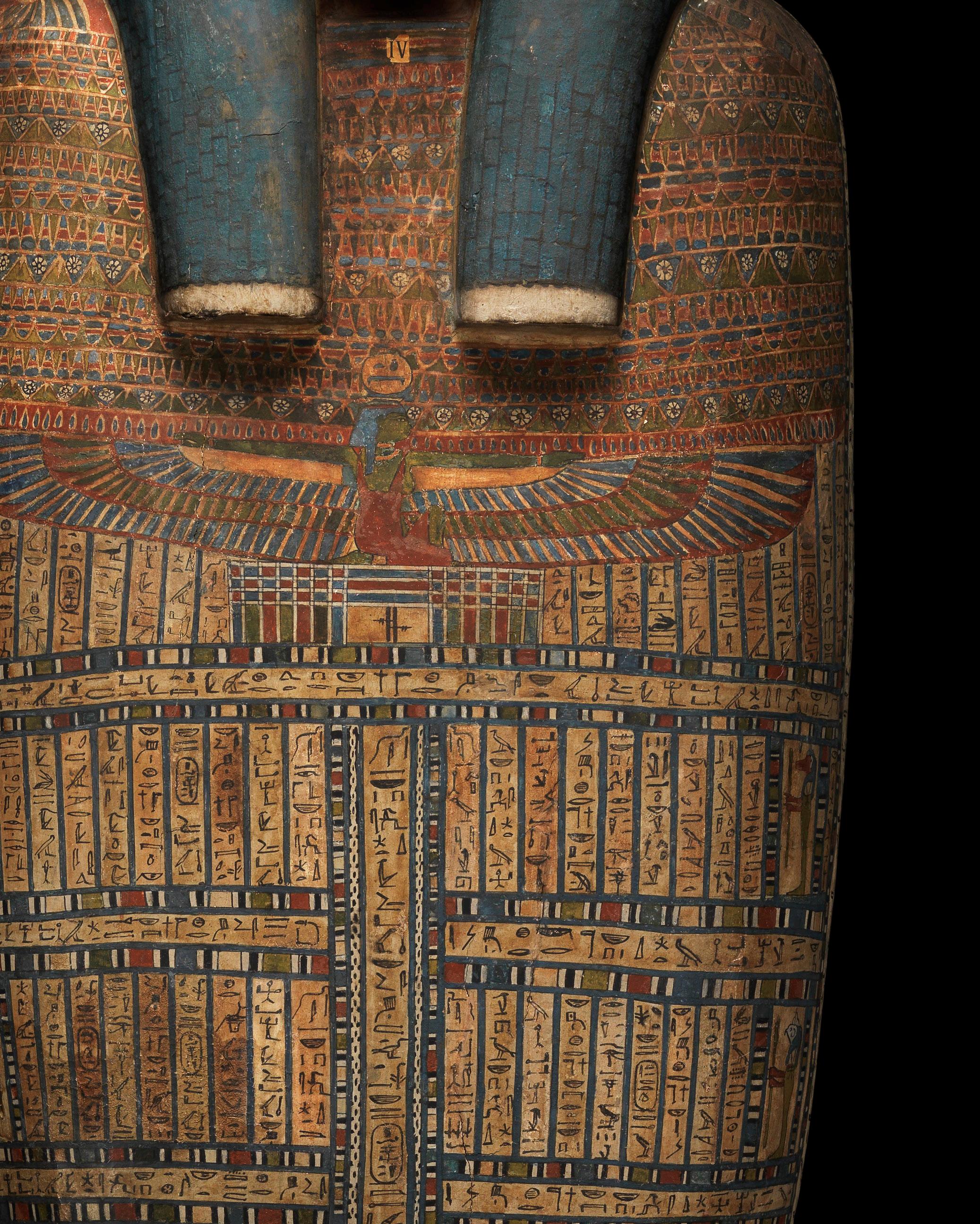

The text of the axial column gives a detailed titulary of the deceased and a spell requiring Nut to return her heart to its right place within her body. Each row of text is devoted to a particular chthonic deity, and framed by an image of the god. For instance, the two upper registers ask for protection from the four sons of Horus, while the row below appeals to Anubis.
The inscription on the axial column translates as:
The august Mistress of the House Sopdet-em-haawt, true of voice and holder of a pension, daughter of the Master of the Two Lands, PeD-jauawy-bastet, true of voice, her mother being Ir-bastet-wdja-nynefw, true of voice, daughter of the Master of the Two Lands, Rudamun, true of voice.
The reverse of the coffin is painted with further inscriptions. Seven columns of offering formulae form a back pillar down the length of the coffin. On either side of these are written praises and sections of Spell 169 from the Book of the Dead, which concerns mummification.
The inner lid of the coffin mentions that Sopdet-em-haawt was the wife of ‘the prophet of Amun-Ra (king) of the gods and scribe of the estate of Montu [lord] of Thebes PadiamunnebnesuKawy', and other members of her family are named on other extant artefacts. Sopdet-em-haawt and PadiamunnesbnesuKawy had a daughter named Tashakheper, known from her coffin (Museo Civico Archeologico, Bologna EG 1961). PadiamunnesbnesuKawy’s son Raemmaakheru was listed as a recipient of goods on a donation stele dated to the year 21 of King Taharqa’s reign (690-664 B.C.).
PadiamunnebnesuKawy’s grandson, who bore the same name, appears among the witnesses of an oracular consultation which took place in the year 14 of King Psammetichus I of the 26th Dynasty and on the Saite oracle papyrus (Brooklyn Museum, New York, 47.218.3).
Evidently Sopdet-em-haawt was married to a member of one of the most important Theban families; her husband was involved in the cults of Amun and of Montu, whose priests were among the most influential people in Thebes from the end of the Libyan Period to the 26th Dynasty.
As Sopdet-em-haawt is descended from two kings, her birth year can be extrapolated, and her coffin demonstrates that she must have lived until child-bearing age.
Her coffin can be dated to either the very end of the 25th Dynasty or, more likely, the beginning of the 26th. This, in combination with the extremely well-preserved decoration, makes Sopdet-emhaawt’s coffin highly important for our knowledge of workshops in the Theban area at the beginning of the Late Period.


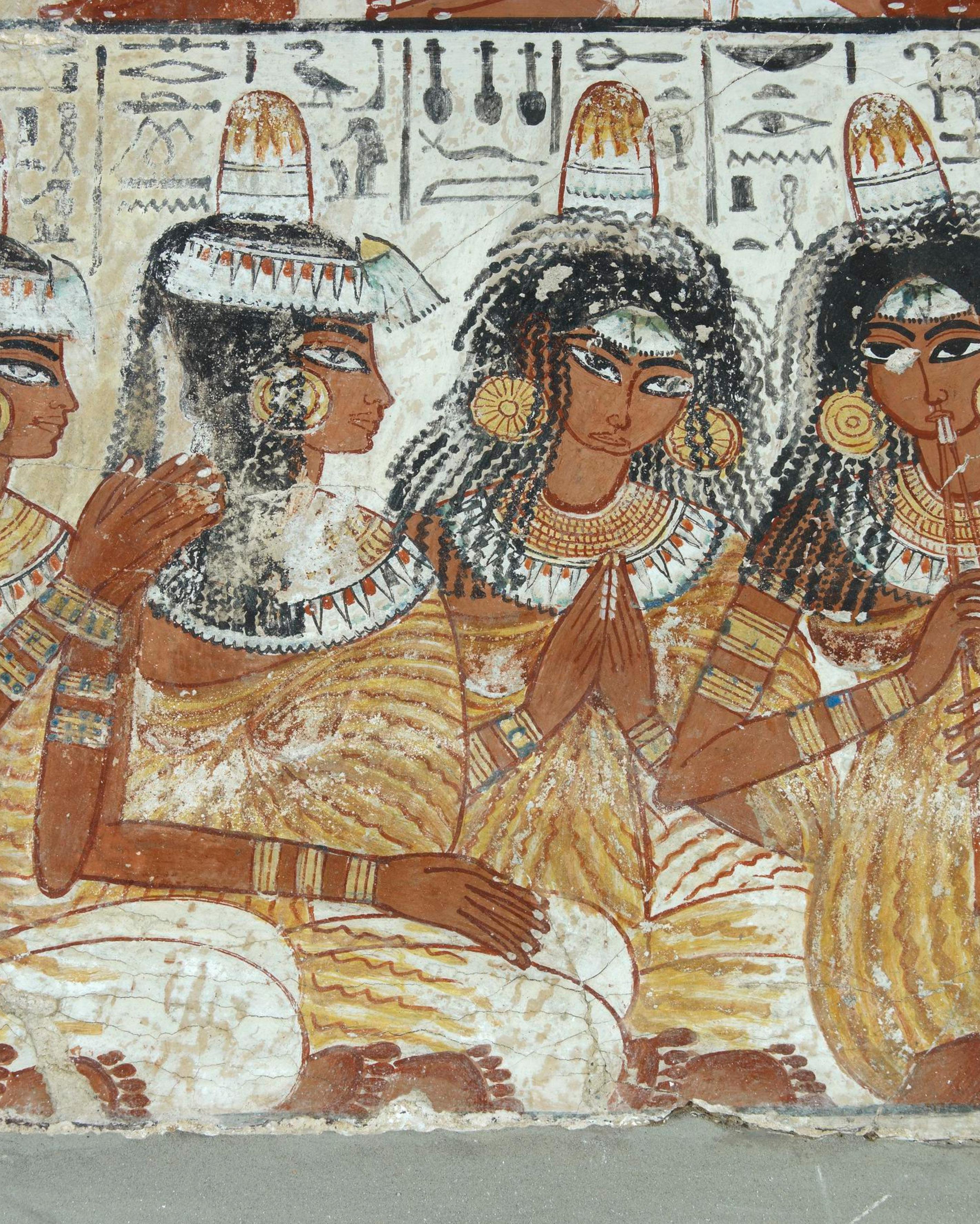
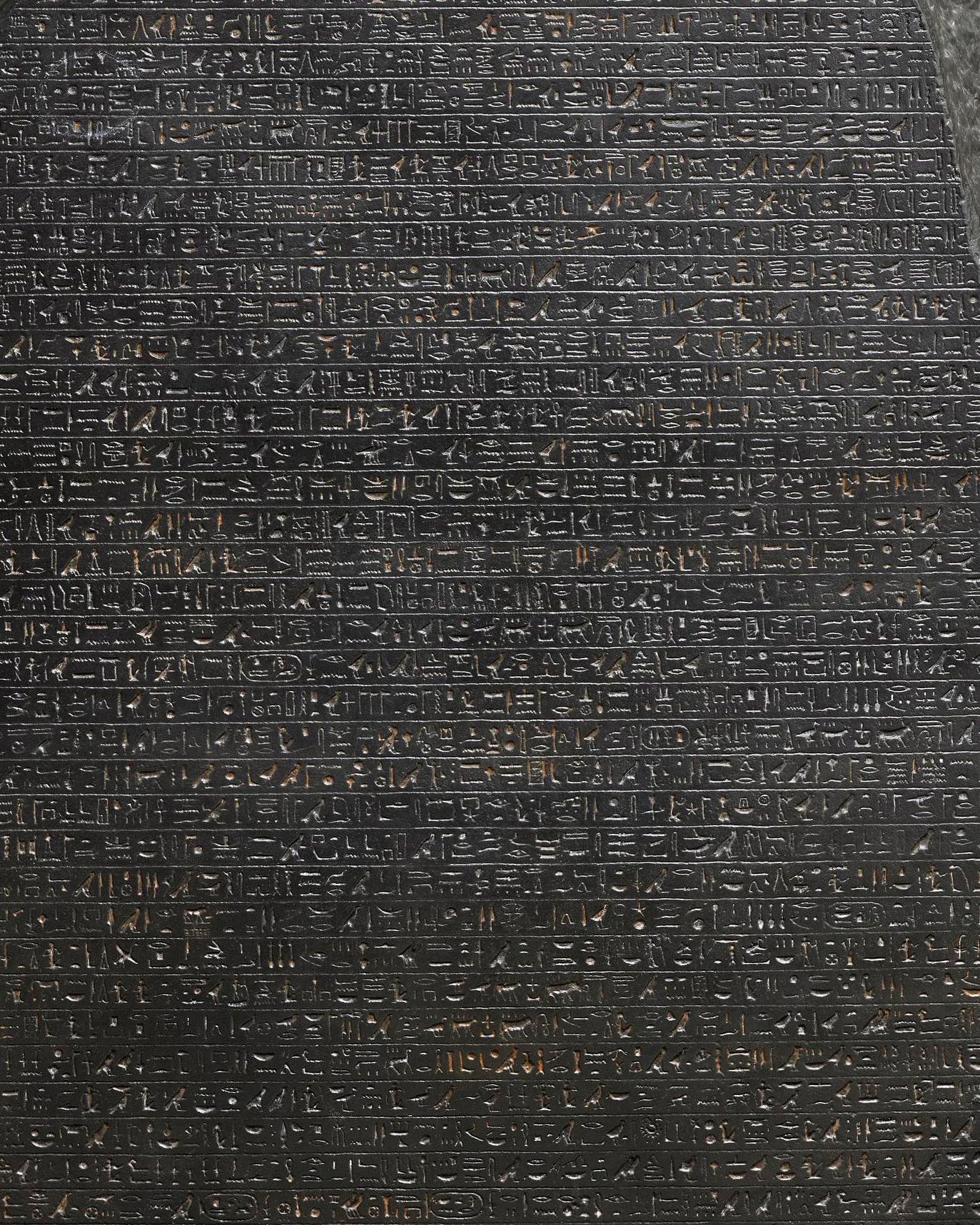
Princess Sopdet-em-haawt lived at the end of the 25th Dynasty and the start of the 26th Dynasty, placing her in a pivotal regime shift between the end of the Third Intermediate Period and the establishment of the Late Period.
The stable period known today as the New Kingdom ended with the death of Ramesses XI in 1077 B.C., and was followed by a period of non-native Egyptian rule now known as the Third Intermediate Period. This was a politically tumultuous period that included the division of the Egyptian empire under different rulers. By the 24th Dynasty, Egypt’s territories had been divided and reunited under different regional rulers. The final Nubian ruler of the 24th Dynasty, Kashta, had extended the influence of his kingdom into Thebes, and his successor, Piye, marched north and defeated the combined forces of native Egyptian rulers around 732 B.C.. Piye then established the 25th Dynasty, and appointed the rulers he had defeated as his provincial governors.
The 25th Dynasty pharaohs originated from the Kingdom of Kush, in modern-day northern Sudan and Upper Egypt. They ruled in Egypt for almost a century, from 744 to 656 B.C., and established the largest Egyptian empire since the New Kingdom. The Kushite rulers adopted and reaffirmed Egypt’s religious, artistic, and literary traditions, and combined them with elements of their own culture. For instance, they used the Egyptian language and writing system for all official records, and oversaw the first widespread construction of pyramids since the Middle Kingdom as well as restoration of monuments and temples in the Nile valley.
By approximately 700 B.C., all of Egypt’s international allies were under the influence of Assyria, and it was becoming clear that an invasion of Lower Egypt would commence to protect Assyrian interests in the Levant. Despite Egypt’s size and wealth, Assyria had a greater supply of timber, and could use it to produce a larger amount of iron weaponry. This disparity gave them the advantage in their conquest of Egypt from 670 to 663 B.C..
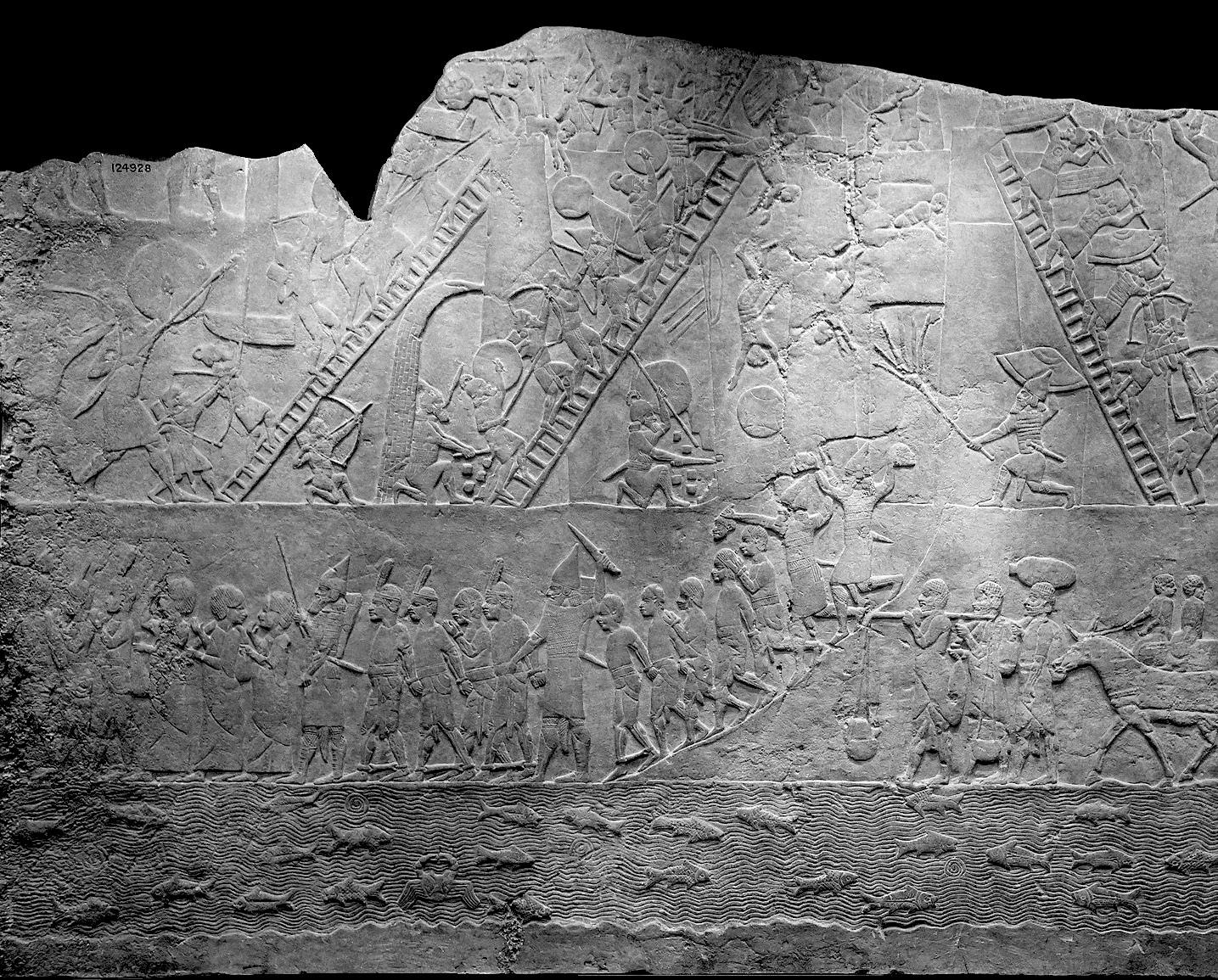
A gypsum panel showing the Assyrian army attacking the Egyptian city of Memphis. It commemorates the final victory of the Assyrian king Ashurbanipal II over the Egyptian king Taharqa in 667 BCE. The Nubian soldiers, recognisable by the single upright feathers on their heads, are being marched off as prisoners. British Museum, London.

During the reigns of pharaoh Taharqa and his successor, Tantamani, Egypt was in constant conflict with the Assyrians. The Assyrian-allied 26th Dynasty rulers initially held Lower Egypt from 664 B.C., while Upper Egypt was under the rule of Taharqa and Tantamani.
In 663 B.C., Tantamani launched a full-scale invasion of Lower Egypt, re-took Memphis and killed Necho I of Sais. In response to this, the Assyrians launched a counter-attack led by Necho’s son, Psamtik I; they forced Tantamani north of Memphis, and sacked Thebes. The Kushites subsequently retreated to their spiritual homeland in Napata, where they established the Kingdom of Kush, which flourished there until around the second century B.C..
Thebes peacefully submitted to Psamtik’s fleet in 656 B.C., and he affirmed his authority there by positioning his daughter in line to be the next Divine Adoratrice of Amun. Psamtik also secured Egypt’s southern border at Elephantine, effectively uniting Egypt. He managed to negotiate freedom from Assyrian control, while maintaining good terms with Ashurbanipal, thus ensuring increased stability for Egypt during his 54-year reign. Because of this, the foundation of the 26th Dynasty is viewed by many as the start of the Late Period.
The 130 year rule of the 26th Dynasty, also known as the Saite Period, ushered in a new phase of artistic expression in stone monuments and statuary, drawing on the long traditions of earlier periods in ancient Egypt. 26th Dynasty art would go on to be emulated by later ruling dynasties of Egypt, as emblematic of ‘Egyptian style’.
Following the fall of the Assyrian empire in 612 B.C., the Saites launched military campaigns into Asia Minor and Nubia. Their armies were supported by foreign mercenaries, who had their own quarters in the capital city of Memphis. A trading settlement with the Greek city-states was established at Naukratis in the western Delta, and Thonis/Heraklion was populated by both Greek and Egyptian locals, facilitating a direct interchange of cultures. The Greeks also settled many other areas in the Delta. The 26th Dynasty came to an end when the Persian empire conquered Egypt in 525 B.C., bringing an end to native rule of Egypt.
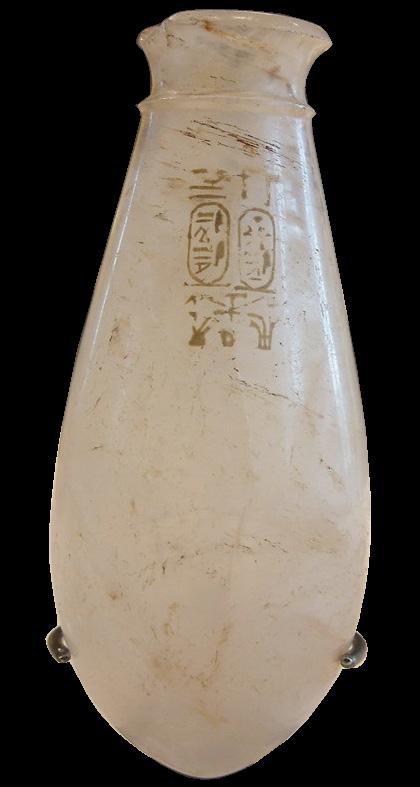
King Rudamun of Upper Egypt and Thebes
Ruled 759 to 739 B.C.
Irbastetwedjanynetu
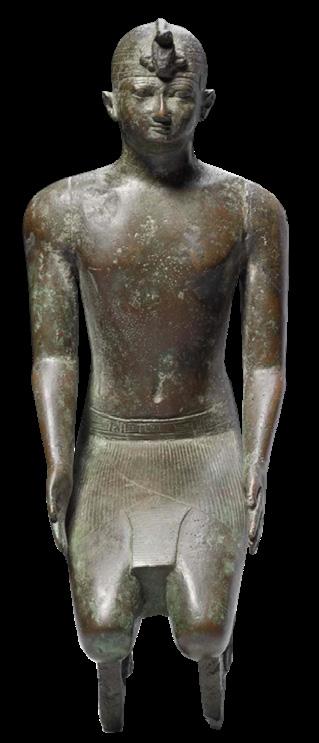

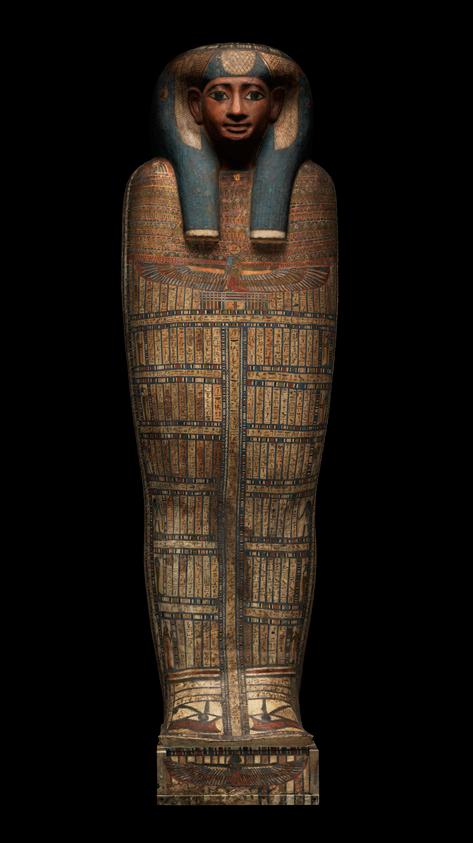


“In their painted caskets, the royal dead lay cocooned in dreams spun from the Nile’s sacred silt, wrapped in the songs of priests and the brushstrokes of artists who adorned wood with whispers of immortality.”

The 25th Dynasty, also called the Kushite Dynasty, ruled Egypt from approximately 747 to 656 B.C., while the 26th Dynasty (circa 664–525 B.C) marked the resurgence of native Egyptian rule under Saite leadership. During this period, Thebes (modern-day Luxor) continued to play an important role as a religious and political centre, particularly for royal women of Libyan descent. This investigation focuses on the Theban women of the 25th and 26th Dynasties, especially those of Libyan royal origin, exploring their roles, titles, and influence in the political and religious spheres of Egypt.
The Libyans had a long history of interaction with Egypt, and by the time of the 25th Dynasty, many Libyan families had gained prominence, both as military leaders and political elites. These elites often intermarried with Egyptian royalty to solidify their power. In the 25th Dynasty, as the Kushite kings sought to stabilise their rule over Egypt, they incorporated Libyan noble families into the royal elite, and many royal women of Libyan origin emerged as key figures. Notable examples include Queen Karamat, wife of King Piye, and her descendants, who maintained power within Theban religious and political circles. These women, while not always in the direct line of succession, often held influential religious roles, serving as high-ranking priestesses or queen consorts'.
During the 26th Dynasty, the rise of the Saite rulers marked a return to Egyptian dominance after the Nubian withdrawal. The Libyan connection, however, remained central to the power structures of the time. The Saites, particularly the kings of the 26th Dynasty, were closely linked to Libyan tribal nobility through marriage alliances. For instance, the marriage of Psamtik I, the founder of the 26th Dynasty, to a Libyan princess solidified his position in the eyes of the Libyan military elites. Royal women of Libyan descent, such as the queen consorts of Psamtik I and his successors, were critical in maintaining these alliances. Princess Sopdet-em-haawt’s own marriage to PadiamunnebnesuKawy is one such example, which would have cemented her family’s ties to the Theban elite.
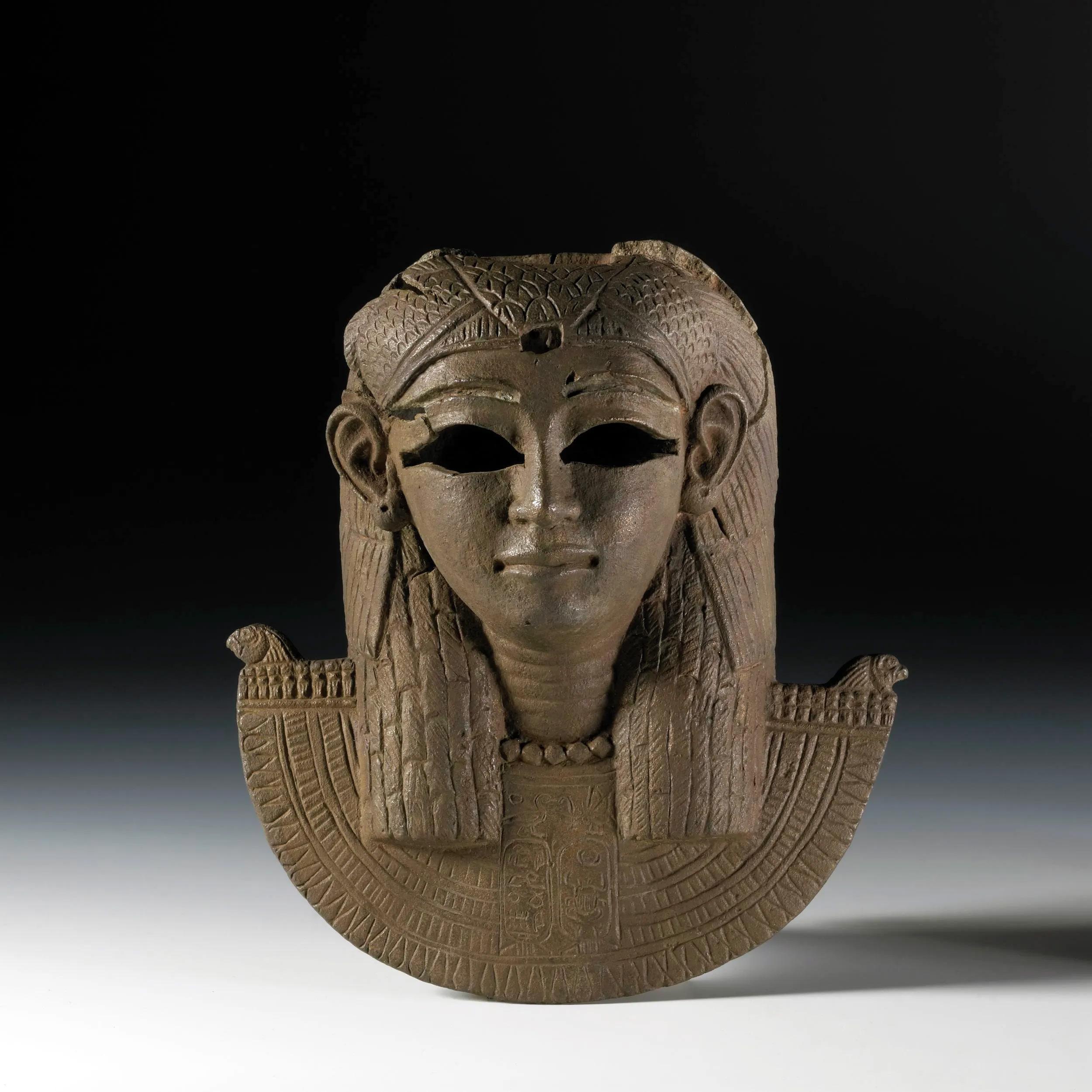
The influence of Libyan women in the 25th and 26th Dynasties extended into the religious and ceremonial realms, with artworks often depicting them as mediators between the divine and human worlds.
Royal women from Nubian and Libyan backgrounds were active participants in the prominent cult of Amun at Thebes, the centre of the god’s cult during this period. They often held titles such as "God's Wife of Amun" or "Great One of the Harem of Amun", which granted them religious influence.
These women, such as Queen Taharqa’s wife, Amenardis I, and later Libyan queens like Nitocris I, exercised influence over the management of the great temples of Thebes and the allocation of land and resources to the priesthood.

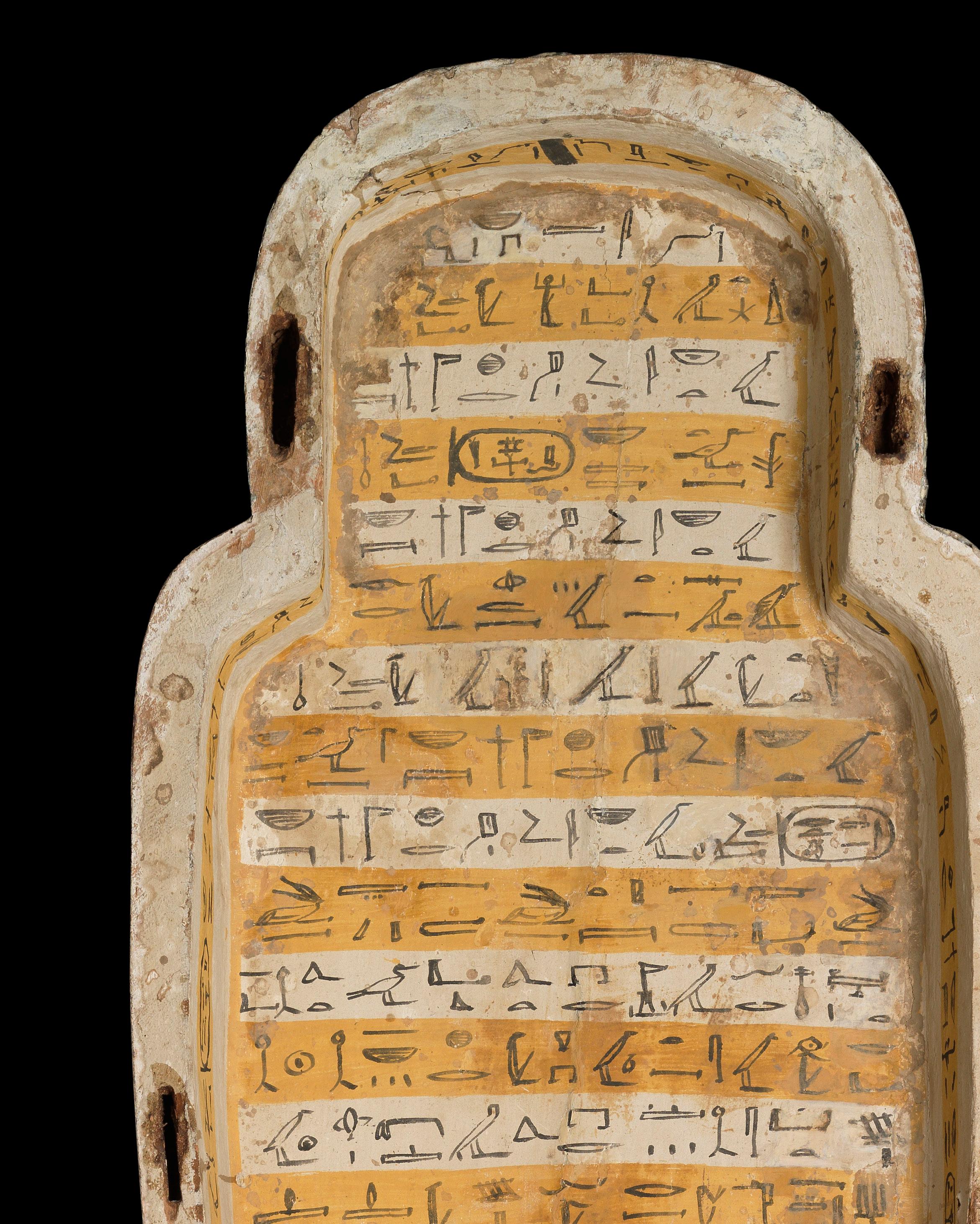

The earliest symbolic role of the ancient Egyptian coffin was as a ‘house’ or eternal dwelling for the deceased. Outer coffins tended to be rectangular, imitating the shape of a tomb or shrine, while inner coffins were mostly anthropoid in form from the Middle Kingdom onwards. From the New Kingdom, coffins were increasingly modelled in forms and dress resembling the living. A letter addressed to the coffin of Ikthay, written by her husband Butehamun in the 21st Dynasty, reads ‘Send this message and say to her, since you are close to her: “How are you doing? How are you?”’. Coffins were seen both as an aspect of the self and as separate to it.
Wood was used as a material for coffins very early in ancient Egyptian history. Cedar was the most prestigious wood, as it provided long, straight planks. However, it had to be imported into Egypt from the Lebanon, making it highly expensive, and a sign of status. Coffins made from local woods, generally sycamore fig, had to collate smaller, irregularly shaped pieces using wooden cramps and dowles and secured at the corners with leather thongs. The lack of divisions between planks on the coffin of Princess Sopdet-em-hawwt suggests it was made from cedar, as befitting her royal status.
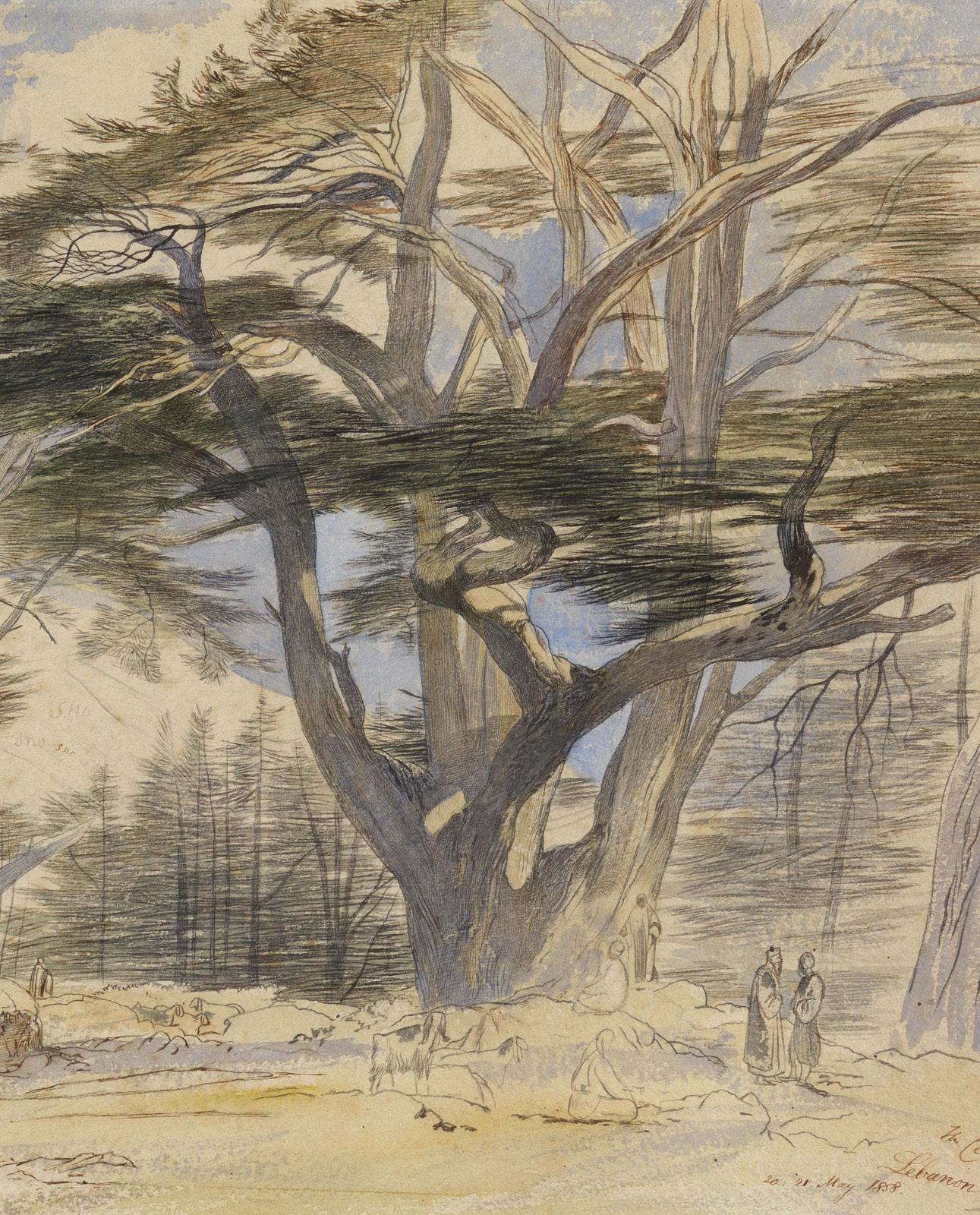
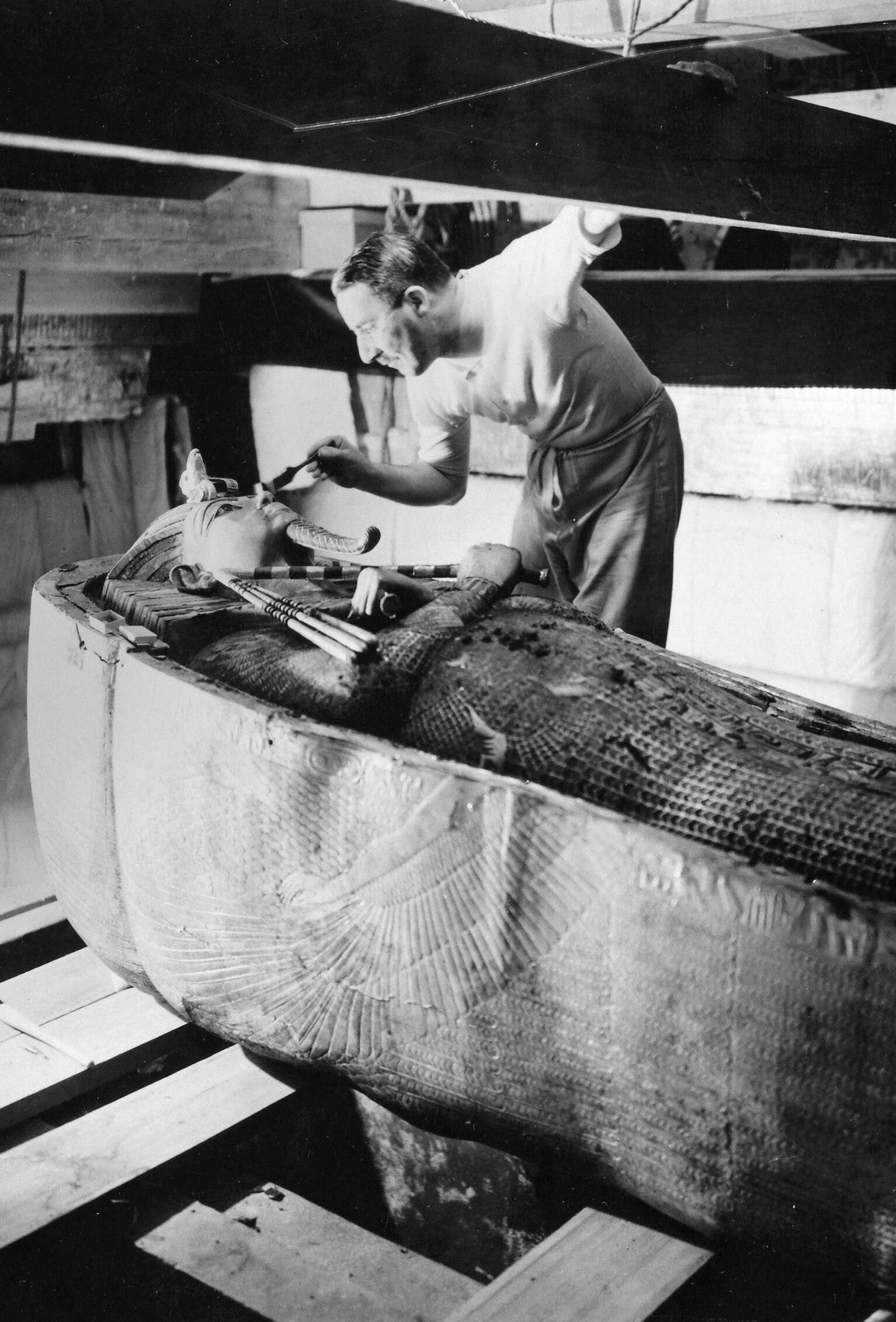
The painted wooden coffin of Sopdet-em-haawt is the inner coffin from what would have been three or four layers of a ‘burial set’.
Ancient Egyptians held a profound belief in the afterlife, where the deceased would continue their existence in another realm. The sarcophagus and coffin sets, often seen in the burials of royals and nobles, played a central role in protecting the body, preserving the soul, and facilitating safe passage to the afterlife.
In the case of high-ranking individuals such as pharaohs or nobles, the body of the deceased was usually encased multiple coffins. The “coffin set” included an outer sarcophagus, inner coffins, and finally, the mummy itself. These layers served both a symbolic and practical function.
The largest outermost layer was typically the most robust. Sometimes carved from stone, this sarcophagus provided protection from outside elements. Inside this sarcophagus, one or more inner coffins would cradle the mummy. The multiple layers represented further protection for the soul, known as the ka, from the dangers of the afterlife.
Inner coffins, especially in the cases of royalty, could be made of wood and painted with intricate designs that reflected the identity and status of the deceased.
One of the most famous examples of a coffin set is that of King Tutankhamun, whose remains were housed in a magnificent threelayered coffin set. The outer two were crafted from wood and gilded, while the innermost coffin was made of solid gold.
The inner sarcophagus of Sopdet-em-haawt represents a unique example of a high-status noble Egyptian burial during her era.

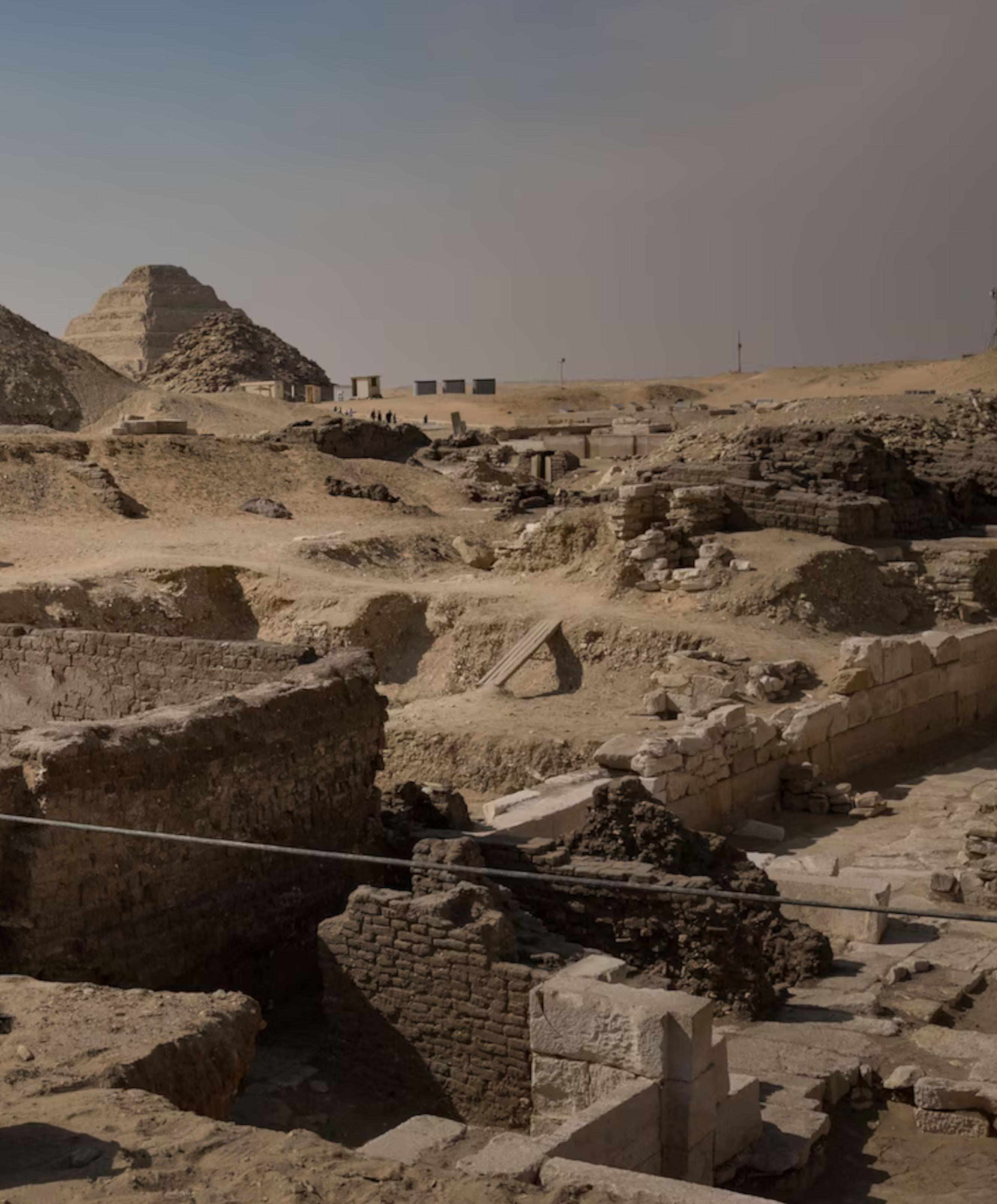
(Previous) The tombs of Saqqara.
Egyptian tombs served many functions. As well as providing physical protection and concealment of the deceased’s body, they represented a transitional space for both the living and the dead. The iconography in the tomb had both religious and funerary functions, with specific spells, rituals, and painted scenes for the maintenance of the funerary cult. Alongside the funerary rituals performed by visitors to the tomb, the tomb walls themselves played a role in ensuring continual renewal of the cult. For private individuals, tombs also served as a form of biography, with scenes relating to their daily lives on the wall. Particularly in the Theban necropolis, situated in close proximity to the village of Deir el-Medina, tombs were an active site, visited by artisans and mourners alike.
As in every period of ancient Egyptian history, the 25th and 26th Dynasty necropoleis were spread throughout the country, and made use of preexisting sites. However, by the 26th Dynasty, two major centres emerged: El Assasif in Thebes, and in Memphis, across Giza and Saqqara. Smaller numbers of tombs have also been found at Abusir, Heliopolis, and the oasis of Bahriya.
Very little is known today about the tombs from this period, whose few archaeological remains are now scattered. Sais, where the royal necropolis of the 26th Dynasty pharaohs was located, and other sites in the Delta region were particularly adversely affected by the poor conditions for preservation there. The rise in water level over time has undermined the foundations of tombs, as has the repurposing of decomposed mud bricks from ancient sites as fertiliser.
Moreover, in antiquity, the site was used as a quarry, and the stones of tombs and temples were reused in other buildings elsewhere – many of the inscribed blocks and sarcophagi from other sites in the Delta can be traced back to the royal necropolis. In fact, many burial sites in the Delta are now known only to us through objects scavenged in ancient history and reused elsewhere.
“...you will see the Beatifications of the ancestors who are on their seats with inimitable richness; you will hear the dispute of those who are speaking loudly to their companions; you will hear the singing of the musicians, the laments of those who are mourning”
The majority of the tombs dating from this period are unadorned and uninscribed, so many can only be dated through the objects found within. Stylistic dating of sarcophagi and coffins, and their inscriptions, have been particularly useful for dating tombs of this period.
The tombs found at El Assasif in Thebes comprise the largest and most highly decorated necropolis from the 25th and 26th Dynasties. In his book on Thebes published in 1835, shortly after the coffin of Princess Sopdet-em-haawt was exported from Egypt, Egyptologist Sir John Gardner Wilkinson described the tombs here as ‘the most remarkable… Their plans, very different from those of other Theban tombs, are not less remarkable for their general resemblance to each other, than for their extent, consistently according with the profusion and detail of their ornamental sculpture’.
Above ground, the Theban tombs were represented by a sun-dried mudbrick structure, covering the area of the subterranean tomb. Both structures of the tombs were generally aligned eastwest, in line with the passage of the sun. The superstructure served as a monumental mortuary temple, featuring pylons bridging three successive courts: the festival court, the offering court (which did not have a floor as it formed part of the deeper substructure), and a sanctuary for the deceased. The pylons were constructed from a single wall enclosing a central vaulted entrance, and their mud-brick structure was probably ballasted with an additional layer of stone casing. The pylons and outer walls sometimes featured a long series of niches. The first pylons were larger than the second and third, and some had staircases giving access to the roof of the tomb. There may have been gardens outside the first pylon, and some tombs also featured small mud-brick pyramids within the superstructure.
The open offering court was a critical element of the Saite Theban tombs. A deep square or rectangular opening into the rock below the surface, it may have served as a well akin to the Osirieion in the tomb of Seti I in Abydos. Like the Osirieion, these wells were lined with pillars or columns, and basins for plants were placed in the grounds of the court. The well was accessed via a niched gate, with a large false door, from the pillared hall without.


The subterranean tomb was connected to the superstructure via a staircase, which began above ground and was covered with a vaulted ceiling below. This stairway generally led to the antechamber, representing the journey from the living world to the underworld in the passage from the exterior to the interior tomb. Some tombs would then have a series of antechambers.
The sacred rooms found in the substructure varied from tomb to tomb. Generally, they comprised of a number of halls, either with or without pillars, with small side rooms or side niches, where family members could be interred. The inner rooms would continue until the offering chamber and sanctuary are reached. The final, innermost room was the burial place. These differ greatly in type and extent throughout the El Assasif tombs, but were generally accessed from the sanctuary and offering chamber via a transverse corridor, leading to other rooms with stairways, until the burial shaft is reached. Other burial shafts were often added when tombs were re-used in later dynasties. In some cases, a second chamber is cut partway down the shaft, possibly as a decoy burial chamber to fool grave robbers. Both the true and the decoy chambers were decorated with a painted vaulted ceiling and false wall, echoing the royal tombs in the Valley of the Kings. Concealed behind the false door was the opening of the true sarcophagus chamber, where the coffin was laid.
The doorways throughout the tombs were frequently inscribed with the biography of the tomb owner, offering texts, and the ‘transfiguration texts’ which allowed visitors of the tomb to confer with the deceased. All of the substructures in the El Assasif necropolis were inscribed to some degree, with texts on topics such as the adoration of the sun, Osiris, and Hathor, and passages from the Book of the Dead. Painted relief scenes of daily life, copied from Old Kingdom tombs, also feature, as do offering scenes. Many of the tombs in the necropolis feature remarkably consistent decorative schemes, allowing archaeologists to extrapolate missing sections in one tomb from those of its neighbours. So too, do they feature characteristic niches, dedicated to Osiris, which frame a statue of the god. These are positioned in the antechambers.
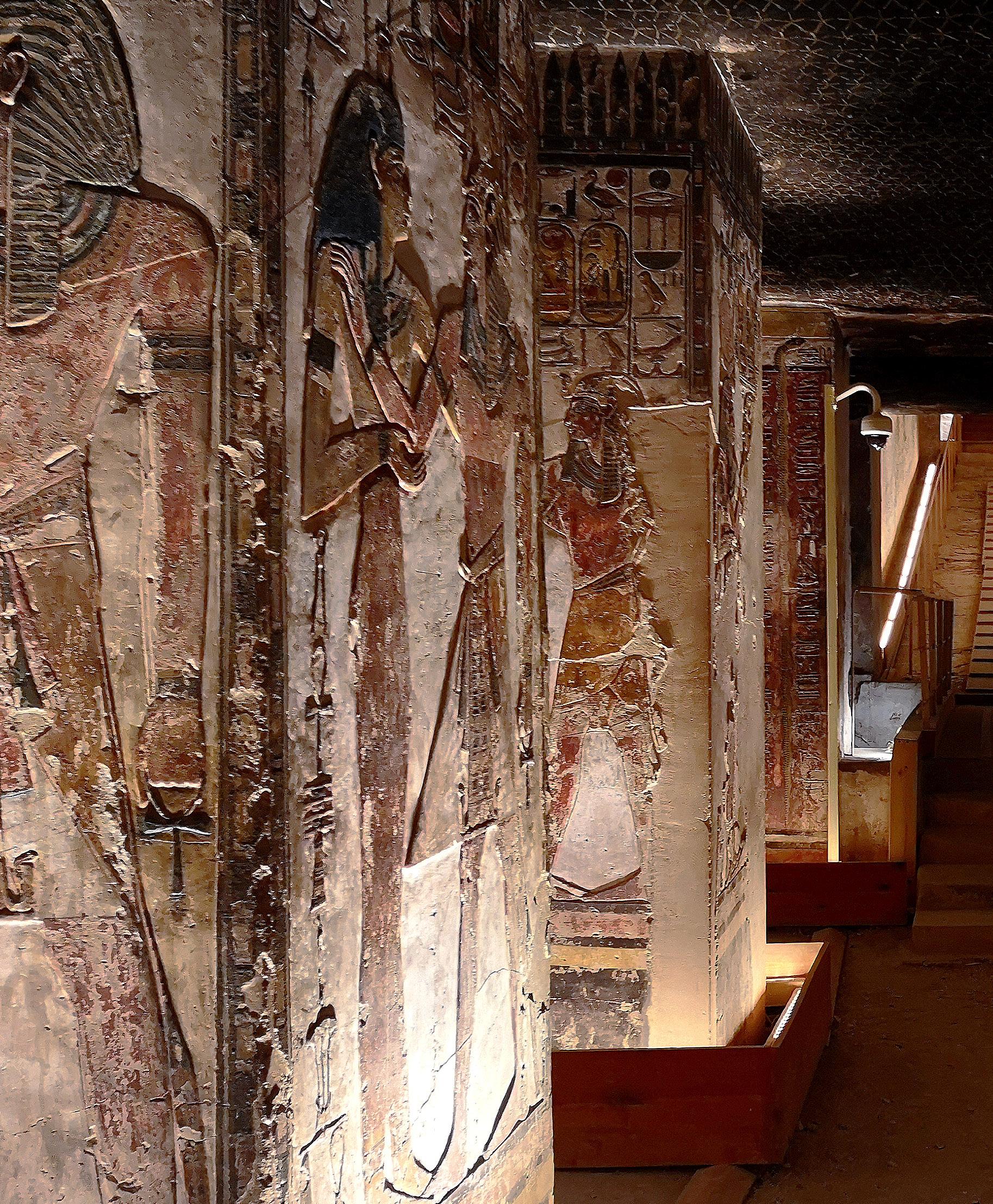

The Decoration of the Coffin of Sopdet-em-haawt.
Painted with a palette of rich blues, greens, and reds, the sarcophagus is decorated inside and out in its entirety with apotropaic symbols and hieroglyphic inscriptions. The inner sarcophagus is usually the most personal, with mentions of the deceased's ancestors and titles. In Sopdet-em-haawt’s case, details on her royal lineage are given, alongside passages from the book of the dead.
Colourful images of Nut, the winged sky goddess, and the goddess of the afterlife, is painted on the chest and feet of the coffin. On the underside of the coffin is an Apis bull, taking Sopdet-emhaawt’s body on its journey into the afterlife. Various other gods and goddesses important to the protection of her body and its journey are painted down each side of the coffin.
The banded yellow and white interior which was rediscovered in 2014 is filled with hieroglyphic text. The choice of colour and design possibly representing the rays of light and its origin in the sun.
1) Neith, worshipped as a funerary deity.
2) Hâpi, god of the Nile.
3) Horus, god of kingship, the sun, and the sky.
4) Qebehsenuef, one of the Four Sons of Horus.


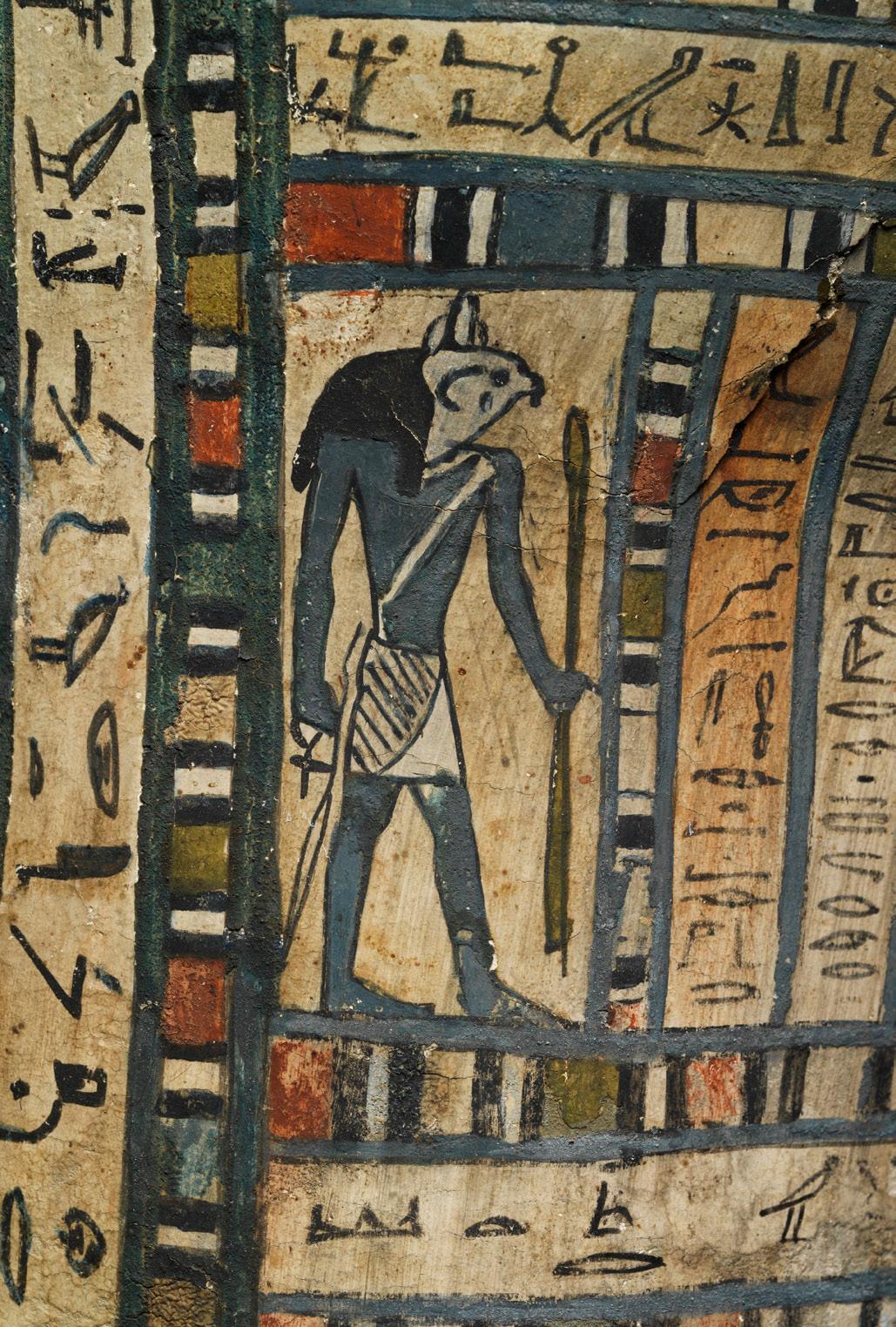


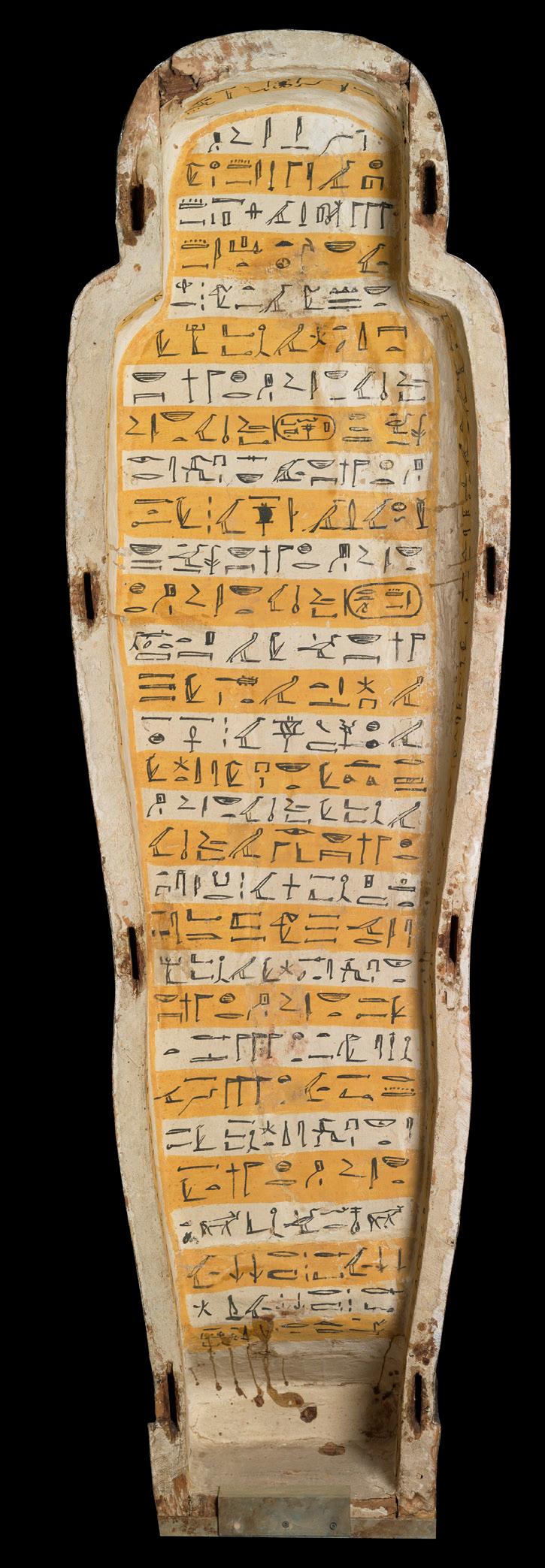
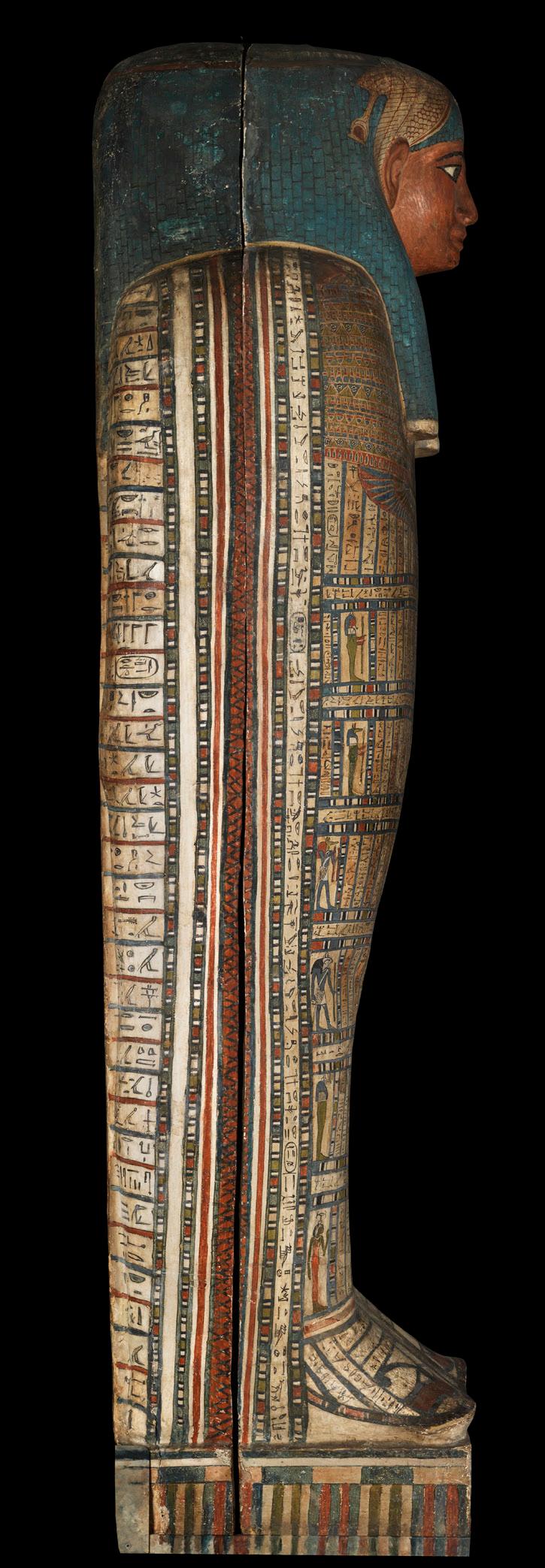


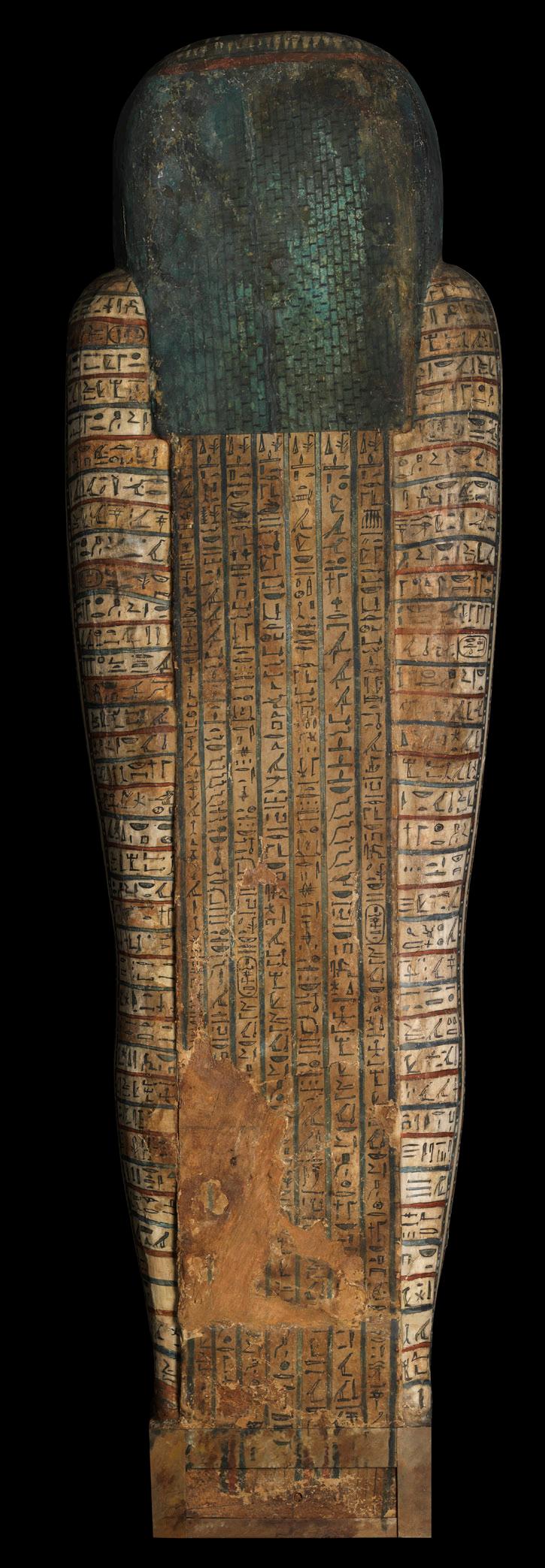
25th and 26th Dynasty coffins incorporated new features into the decoration of their coffins, such as a fringed wig. They also included wedjat eyes on the feet, and the Apis bull carrying the coffin on the underside of the base. The coffin’s structure was amended slightly, incorporating the pedestal base and back pillar previously seen on statues. Traditional features, such as the kneeling image of Nut on the chest, were updated – 25th and 26th Dynasty coffins added the hieroglyph for gold ‘nbw’ underneath the goddess.
The Apis bull’s role in the funerary cult was longstanding, with the Coffin Texts (such as CT III, 138a, 140a) and Book of Dead Spell 189 referring to the sacred bull. In the New Kingdom, Apis bulls were accorded the full mummification rites and interred at the cemetery of Saqqara in grand sarcophagi. The Apis was a protector of the deceased; as one of the forms of Osiris, it was believed that the bull had the power to grant the soul control over the four winds in the afterlife. Elites of the 22nd Dynasty had decorated the footboards of their cartonnage coffins with the Apis bull, but it was not until the 25th and 26th Dynasties that the mummiform image of the coffin-owner was shown tied to the bull’s back.


"Come for my soul, O you wardens of the sky! If you delay letting my soul see my corpse, you will find the eye of Horus standing up thus against you ... The sacred barque will be joyful and the great god will proceed in peace when you allow this soul of mine to ascend vindicated to the gods... May it see my corpse, may it rest on my mummy, which will never be destroyed or perish."
Book of the Dead, spell 89.
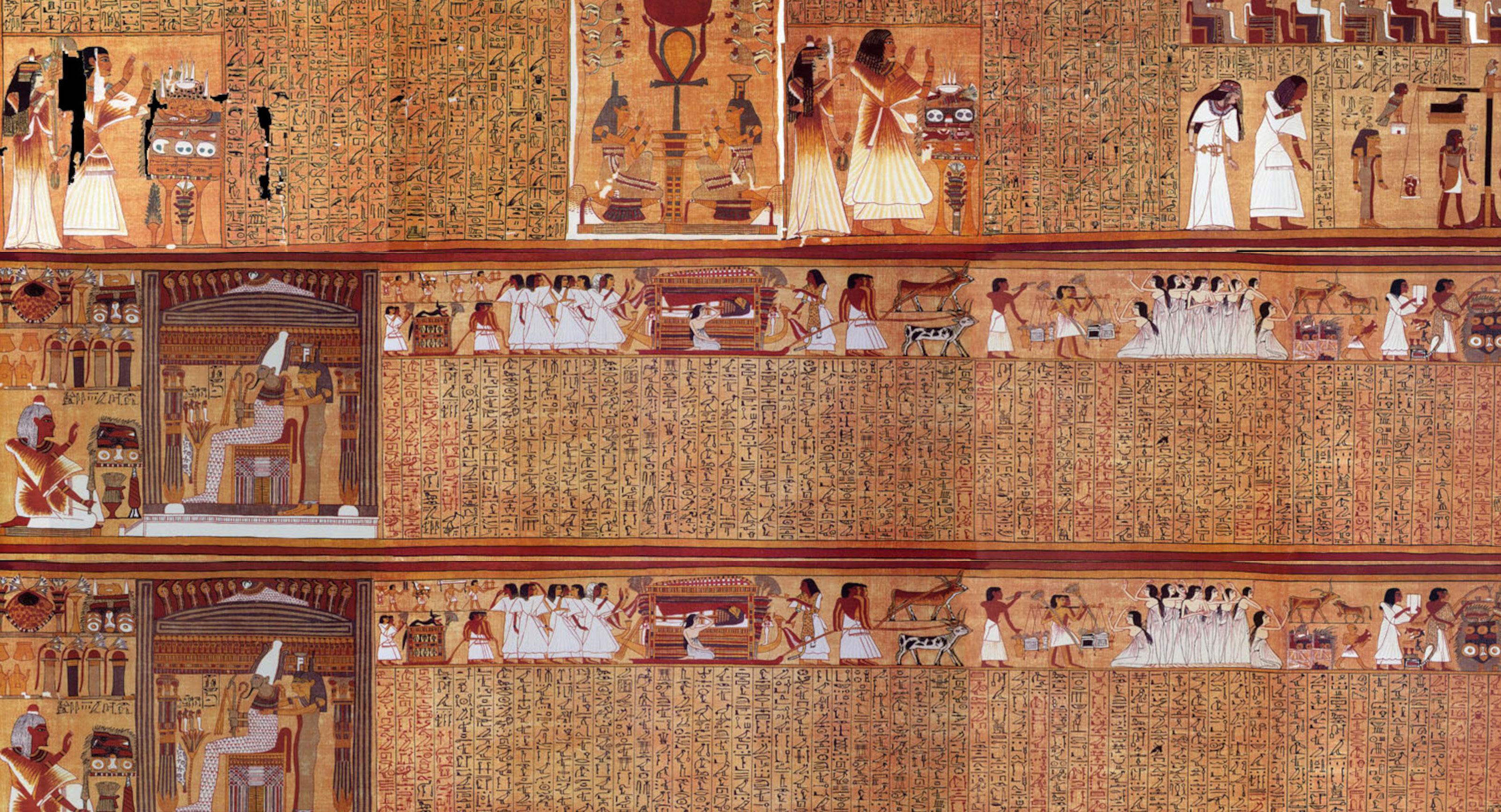
The Book of the Dead is the modern name given to an ancient Egyptian collection of spells designed to help the soul on its hazardous journey through the afterlife. Some of the spells were designed to ensure the deceased could still control their own body after death, and to keep the integral parts of the head, heart, and spirit together. Others were to ensure the body didn’t decay, and could remain capable of breathing air, having water to drink and food to eat. The spells provided protection against snakes, crocodiles, insects, gods and demons that could pose a danger to them in the afterlife.
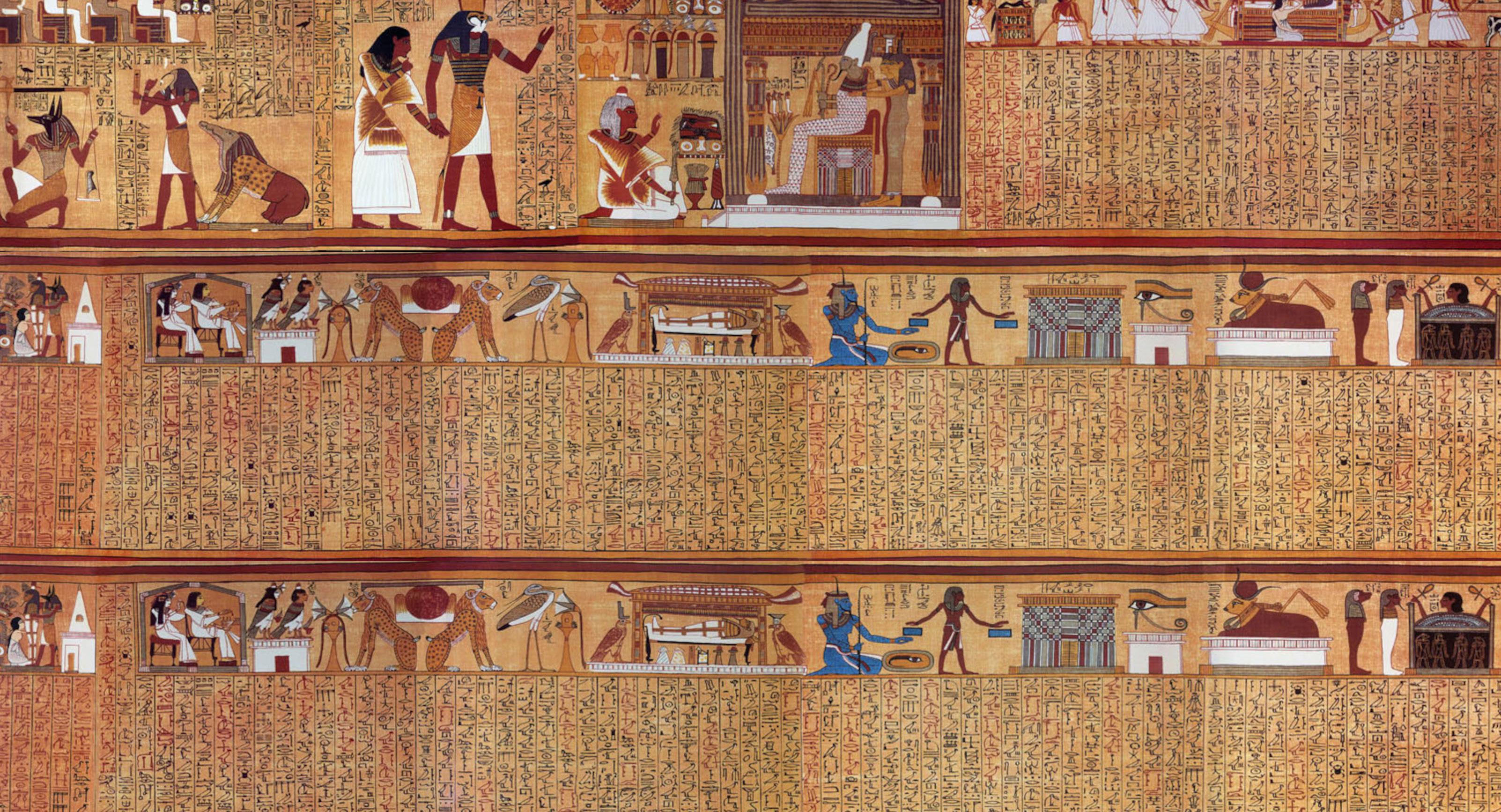
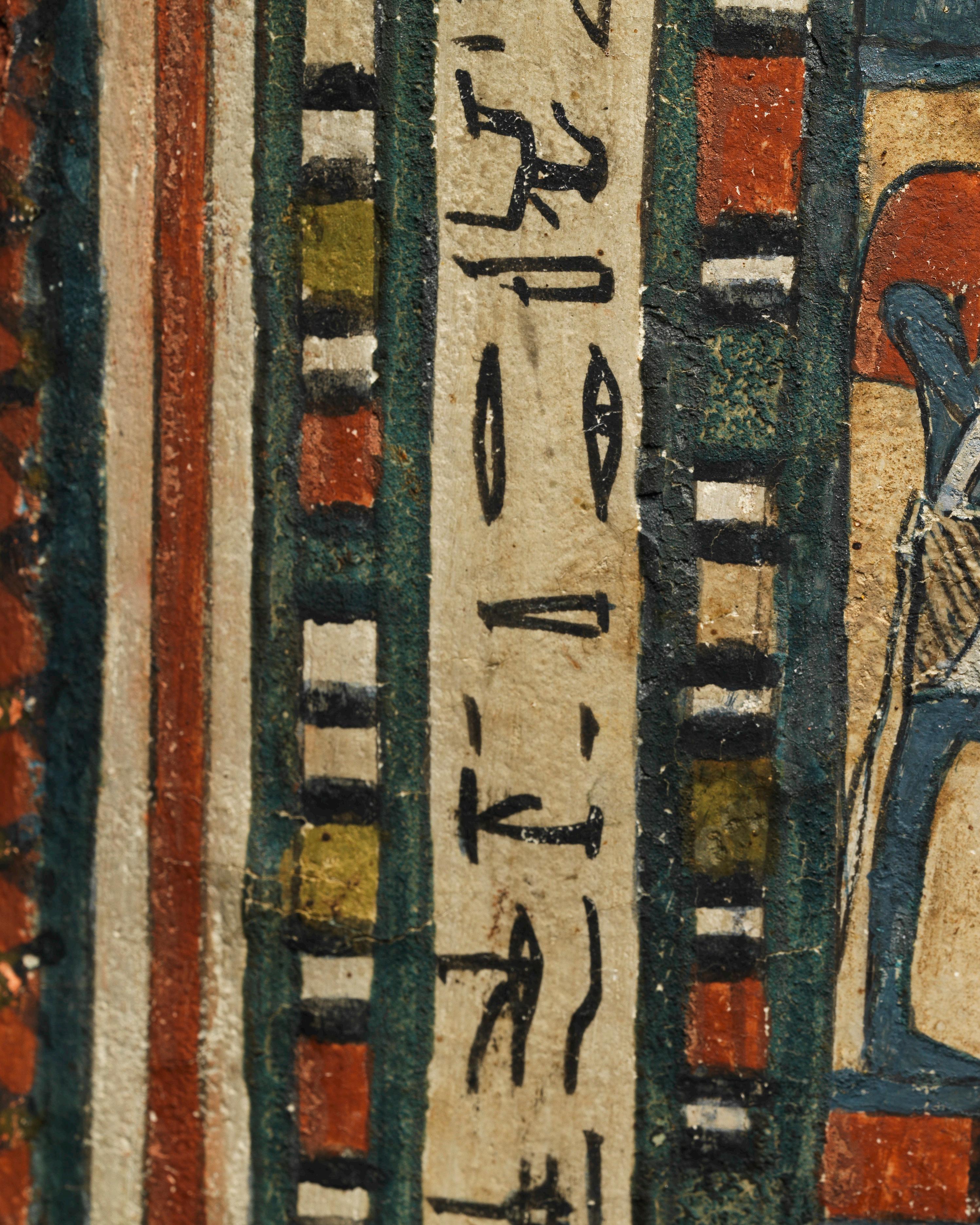


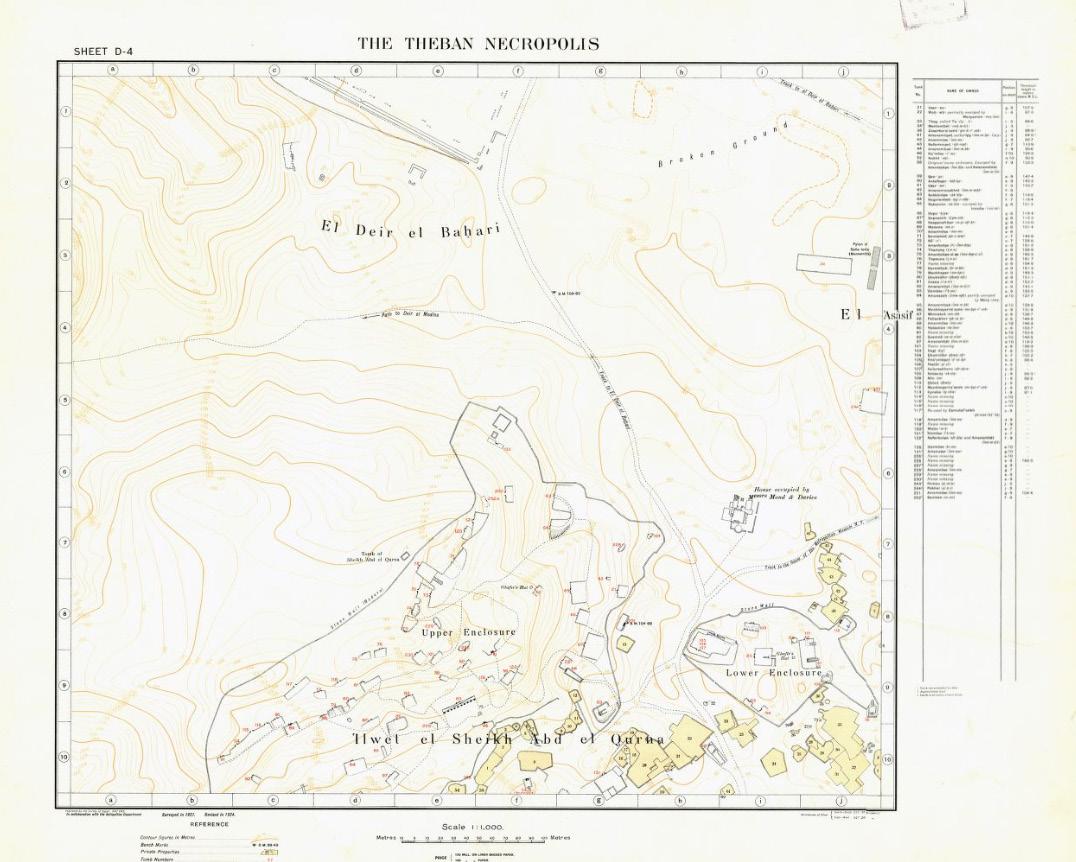
The Coffin of Princess Sopdet-em-haawt originates from Heracleopolis Magna, Egypt, probably from the Theban necropolis at Sheikh Abd-el Qurna.
Discovered in 1832, according to handwritten note inside the coffin, and recorded by Robert Hay (1799-1863) in a notebook between 1832 and 1834, under the heading ‘Inscriptions on a Mummy Case’, British Library, London, Add.MSS.29827, fol. 83 verso.
Private Collection of Jules Xavier Saguez de Breuvery (1805-1876), Saint-Germain-en-Laye and brought from Egypt to France in 1834, according to handwritten note inside the coffin.
Private Collection of Monsieur Maffre de Baugé, Sète, acquired in the 1970s or earlier.
Thence by descent to his daughter, Mademoiselle Cendrine Maffre de Baugé, France.
Sold at: Egyptian, Classical & Western Asiatic Antiquities, Sotheby’s, New York, 12 December 2013, Lot 15.
Private American Collection, acquired from the above sale.
The coffin was opened in 2014, and details of its discovery in Sakara 1832 and acquisition by Jules Xavier Saguez de Breuvery and exportation from Egypt in 1834 were exposed in a handwritten note on the interior.
With David Aaron Ltd., London, acquired from the above in 2017.
ALR: S00218852, with IADAA Certificate, this item has been checked against the Interpol database.

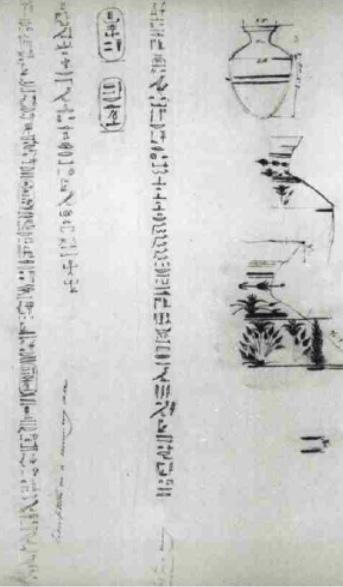
(Above) ‘Inscriptions on a Mummy Case’, Field notebook of Robert Hay, British Library, London, Add. MSS.29827, fol. 83 verso.
(Left) Robert Hay (1793-1893).
The Scottish explorer, antiquarian, and Egyptologist, Robert Hay (17931893) spent more than eight years recording the ancient temples and tombs along the Nile.
Famous for his intricate drawings of Cairo and Egyptian landscapes, he also invested time documenting archaeological finds. He was the first person to make a known record of the coffin of Sopdet-em-haawt: he copied the cental column of hieroglyphic text running down the length of the coffin in one of his field notebooks between 1829 and 1834 and titled it ‘Inscriptions on a Mummy Case’.
The coffin was discovered nearly 10 years after Jean-François Champollion’s deciphering of the Rosetta Stone, and it is possible Hay understood the importance of this particular column and made sure to make notes of the symbols for further decoding. His field notebooks are now kept in the archives of the British Museum.

In 2014, during conservation, the sarcophagus was opened for what is known to be the first time in two centuries. This revealed the yellow and white striped and highly inscribed interior, and a handwritten pencil note from 1834 which reads ‘Discovered in Sakara in 1832, brought from Egypt by M.J Breuery in 1834.’
Decouverte à Sakara en 1832 / rapportée d’egypte par M.J. de Breu[ery] / En 1834
This piece of information was significant in helping pinpoint when the sarcophagus entered the private collection of archaeologist and politician Jules Xavier Saguez de Breuvery (1805-1876), who resided in, and was Mayor of, Saint-Germain-en-Laye in northern central France.
It is not known who wrote the note, but it can be presumed it was de Breuvery himself.
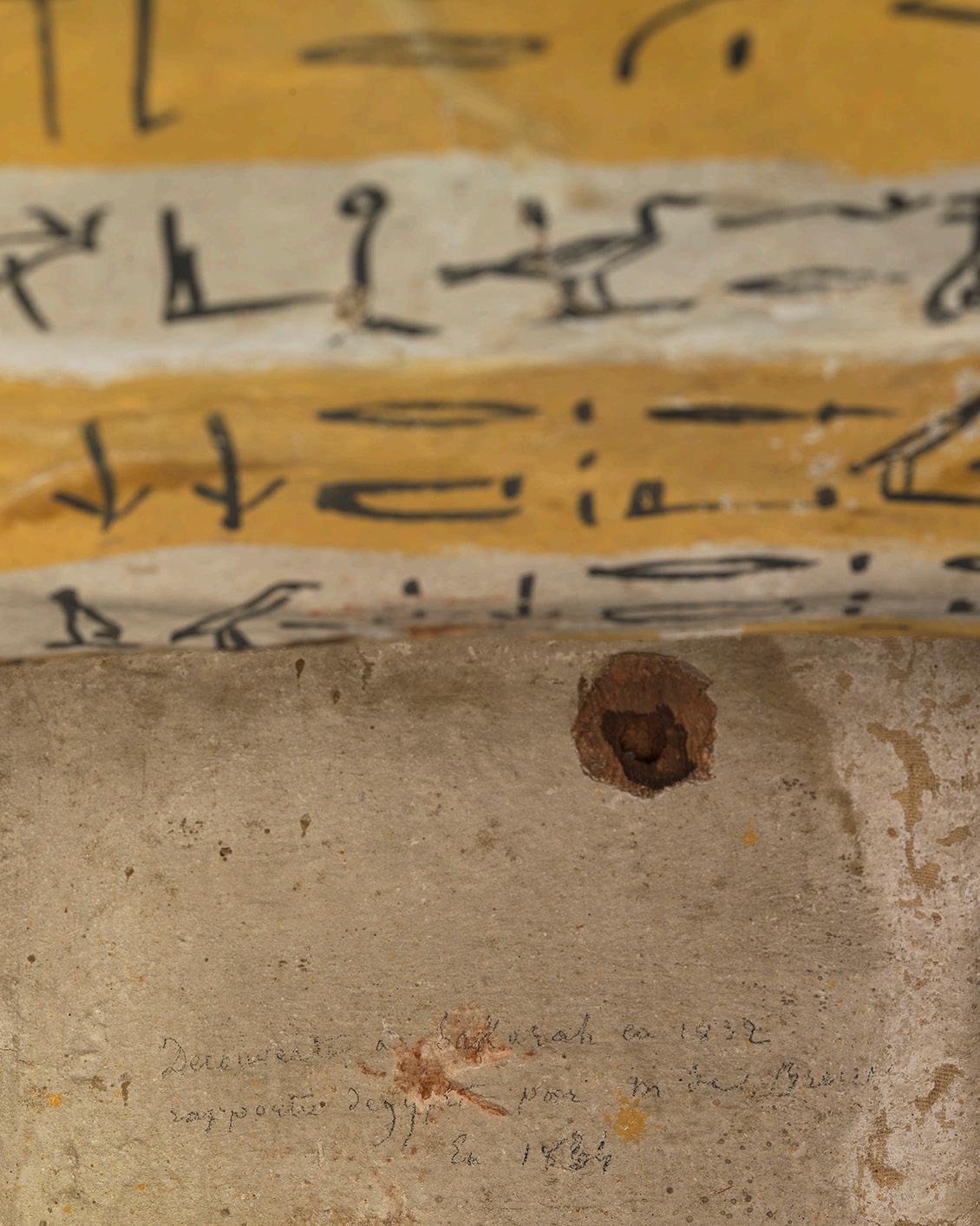
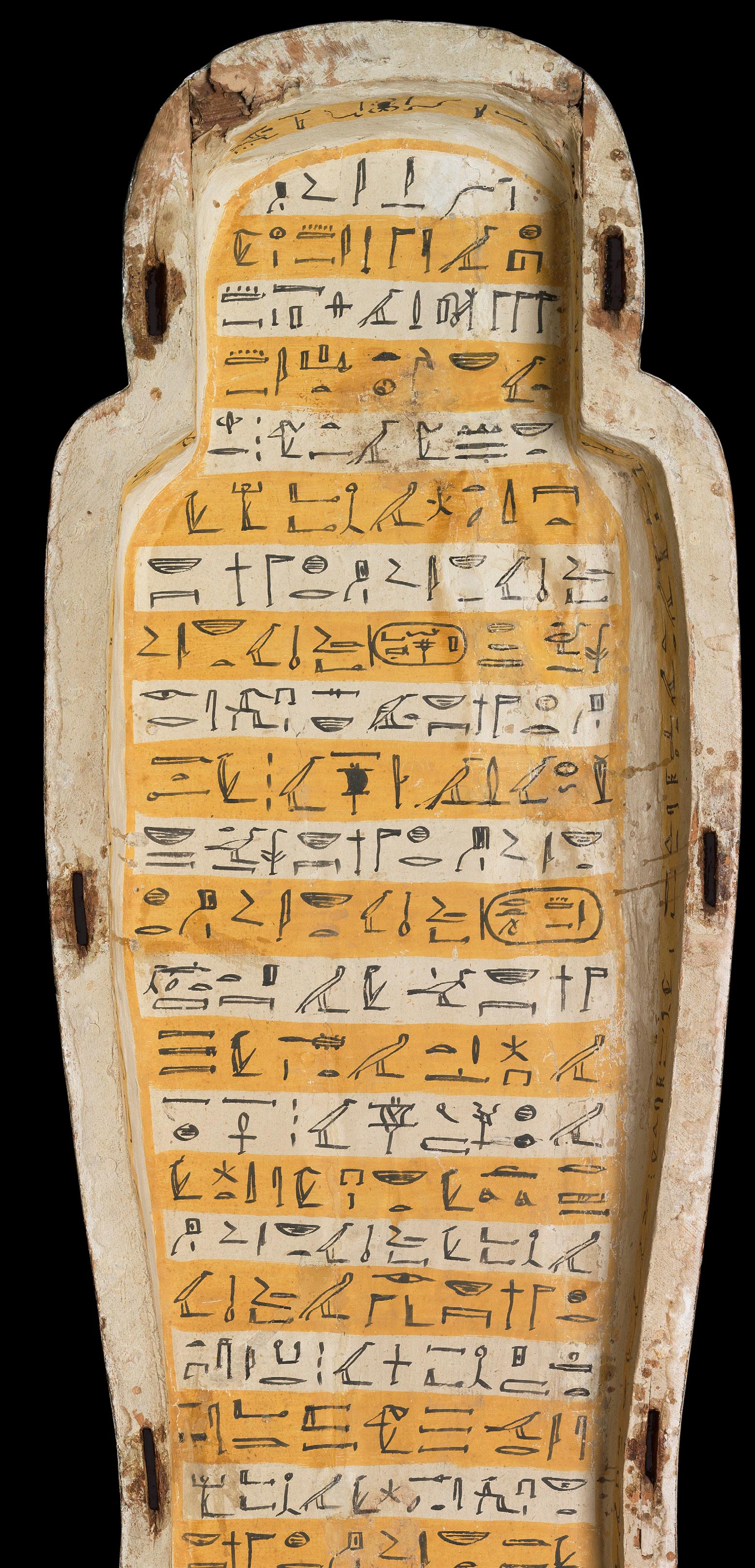
'Le cercueil intérieur de la princesse Sopdet-em-hââout'
Raphaële Meffre, in Monuments et mémoires de la Fondation Eugène Piot (2015).
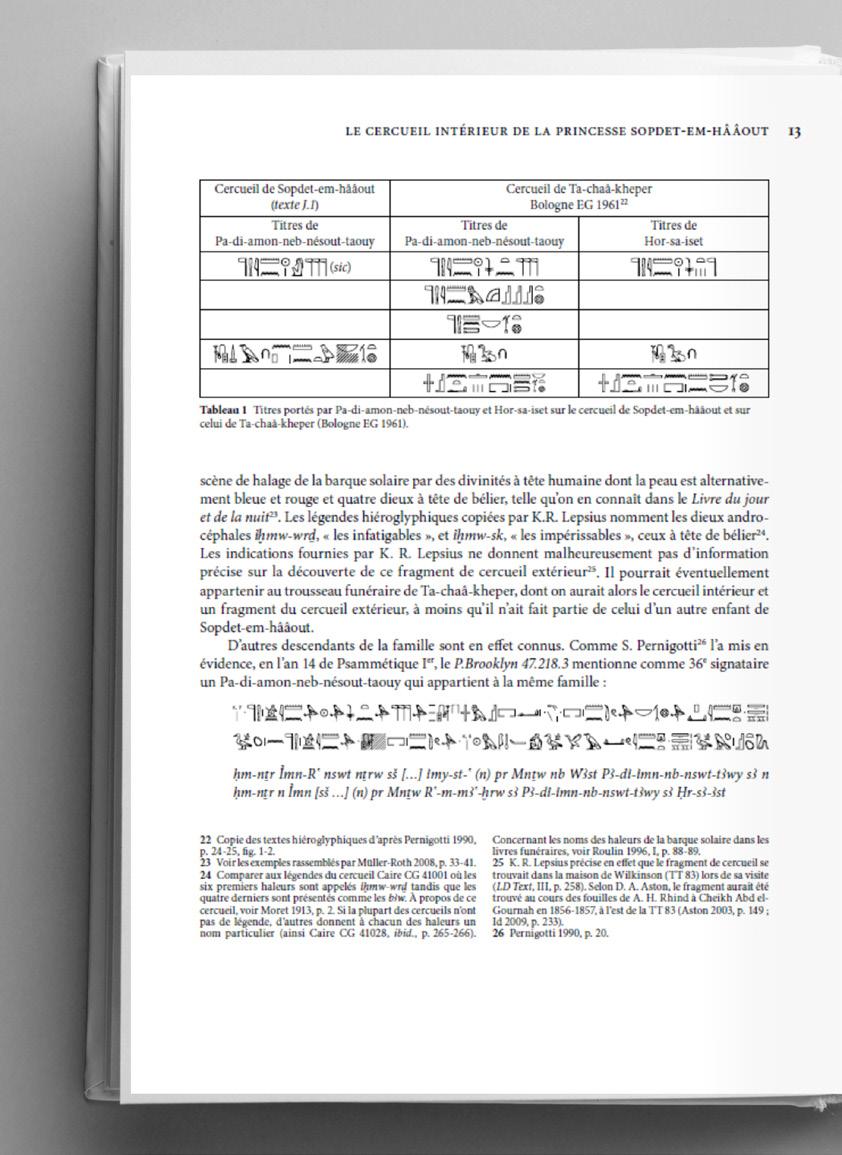
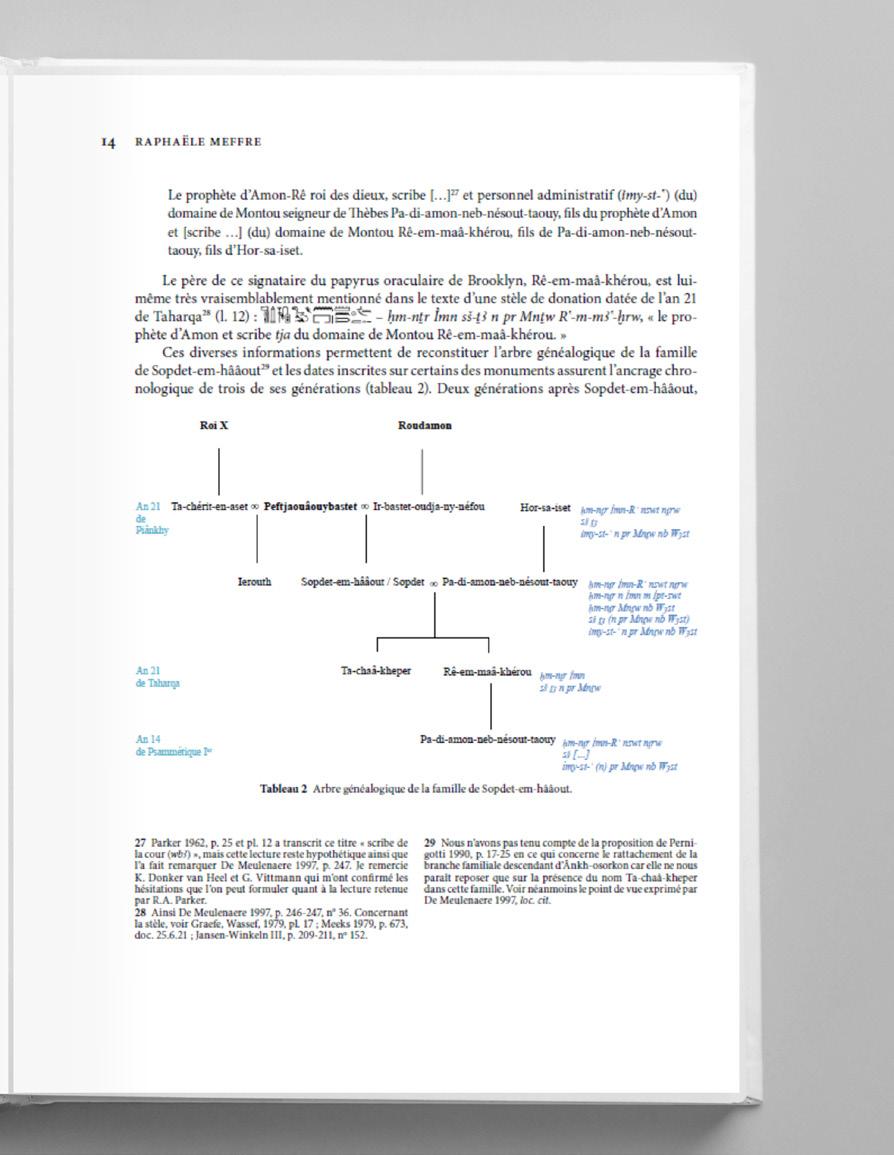
(Above) Le cercueil intérieur de la princesse Sopdet-em-hââout, a 54 page journal entry by Raphaële Meffre in Monuments et mémoires de la Fondation Eugène Piot, (2015).
In 2009, Raphaële Meffre wrote a journal entry for the highly regarded Revue d’Égyptologie. In this study she examined the lineage of the Royal Theban family of Libyan descent, which Sopdet-em-haawt belonged to.
Meffre studied inscriptions on various artfeacts from the 25th / 26th Dynasty, including a block statue in the Pushkin Museum, Moscow (I.1.a. 5736) and a now lost coffin panel in Berlin (AS 2100). Knowledge of Sopdet-em-haawt and her ancestry came from analysing the inscription drawn in Robert Hays' notebook titled ‘Inscriptions on a mummy case’. At this time, the physical coffin’s whereabouts was unknown and her study was limited to this single line of hieroglyphics transcribed in the 1830's.
In 2013, the coffin was offered for sale at Sotheby’s, New York, generating a lot of buzz surrounding its rediscovery. However, it was not until 2014 when the coffin was painstakingly cleaned, conserved, and opened by conservators that much of the external hieroglyphics were made visible and the incredible striped interior inscriptions were uncovered for the first time.
This treasure trove of ancient information spurred Meffre to revisit her investigation of the coffin. In 2015, she published a 54 page journal entry for Monuments et mémoires de la Fondation Eugène Piot including a complete translation of the texts on the inside and outside of the coffin.


Robert Hay (1793-1893), was a Scottish explorer, antiquarian, and early Egyptologist. Born at Duns Castle in Berwickshire into a wellestablished Scottish family, he joined the Royal Navy at the age of 13, thus following a family tradition of service in the armed forces. Navy service brought him to Alexandria in 1818 and this visit, coupled with reading the works of Italian explorer and archaeologist Giovanni Belzoni, inspired him to return to Egypt and travel.
For almost ten years beginning in 1824, Hay explored Egypt, recording the ancient temples and tombs along the Nile, not merely by making sketches and brief descriptions, as earlier travelers had done, but thoroughly, with architectural plans and detailed copies of the murals and inscriptions. Robert Hay was typical of the new generation of antiquarians, and he was wealthy enough to employ a number of artists, who were greatly assisted in their work by the use of the camera lucida, a portable device which facilitated the making of exact drawings. Other artists who worked with or for Hay included Joseph Bonomi, who had trained as a sculptor, and Francis Arundale, who had studied architecture and painting.
In 1828, Hay married Kalitza Psaraki, she accompanied him during the rest of his exploration of Egypt. Hay died in East Lothian, Scotland, in 1863. His collection of artefacts and plaster casts was purchased by the British Museum, except for some objects which were sold to a Boston banker and form part of the collection of the Museum of Fine Arts in Boston.
The vast corpus of his drawings, paintings, plans, notebooks and diaries is kept in the British Library and it is often consulted by Egyptologists wishing to see tombs, temples and wall paintings in a less deteriorated and damaged state, as they were in the 1820s. Aside from one book - “Illustrations of Cairo”, published in 1840– none of Hay’s other work was published. This collection of lithographs did not sell well because of its exorbitant price, but the images are of great value to scholars.
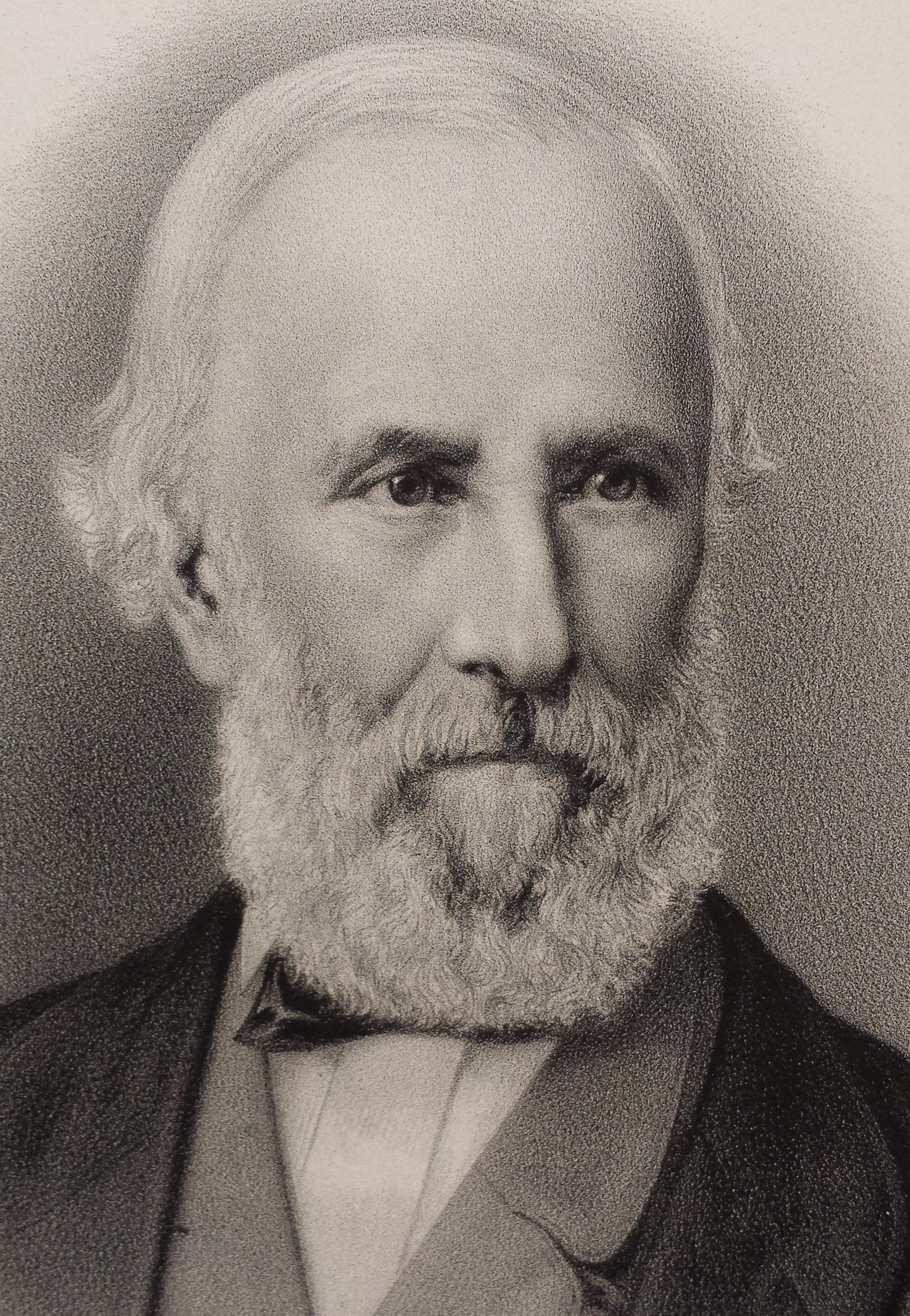
Jules Xavier Saguez de Breuvery (1805-1876) belonged to the Saguez de Breuvery family of French nobility, native to Champagne, whose lineage goes back to Jean Saguez Esq., fifteenth-century lord of the stronghold of Montmorillon les Marson.
On 14 November 1835, at the age of only 30, de Breuvery was elected mayor of Saint-Germain-en-Laye. From 1848 to 1874, he acted as general counsellor of Seine-et-Oise without interruption and had a street named after him in the city of Saint-Germain-en-Laye. Furthermore, he was knighted into the Imperial Order of the Legion of Honor on 22 August 1858 (register 38 F106 No. Q2051) and made a knight of the Order of the Holy Sepulchre of Jerusalem on 19 July 1836.
De Breuvery was a geographer by training, an archaeologist and an avid traveller. He exhibited in the antique art section of the 1878 World Fair and published several books in the early 19th century. He bequeathed a portion of his archaeological finds to the Musée d’Archéologie nationale in the Château de Saint-Germain-en-Laye.
Between 1829 and 1832, de Breuvery travelled the Near East, Egypt and Sudan, accompanied by Édouard Pierre Marie de Cadalvène. An account of their journey was published in four volumes, alongside reflections on social and political aspects of the Ottoman Empire.
The pair visited the Theban area twice, and met several people involved in the local antiquities trade. De Breuvery made several purchases of antiquities during his journey. Among the objects he brought back to France are a caryatide statue from Halicarnassus (Musée du Louvre, Paris, MNC 1382) and the coffin of Princess Sopdet-em-haawt.
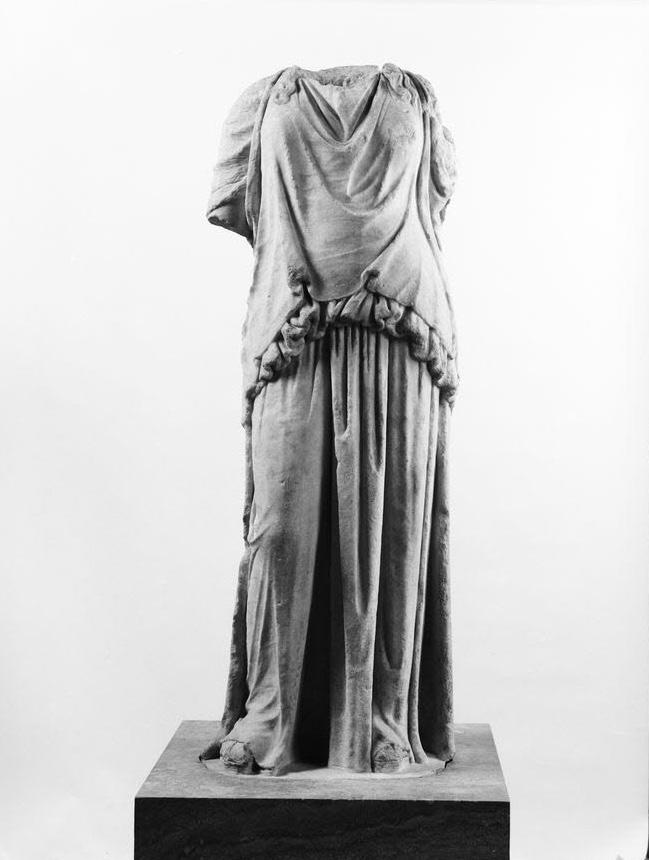
In 1829, de Breuvery and de Cadalvène began their journey through Egypt at Alexandria. Their publication of their travels notes that they spent some time in the city, visiting sites such as Pompey’s Pillar and Cleopatra’s Needles. From here, they set out to Rosetta and Fuwwah, before continuing on to Damietta, where they began their journey down the Nile. Whilst staying in Cairo, the pair toured the pyramids of Giza, Heliopolis, and other notable regions from antiquity. They continued on to Faiyum and to the famous tombs at Beni Hasan, then down towards Abydos, Qurna, where they travelled to the temple at Denderra, before arriving at Thebes.
‘Before us lay the immense plain which the ancient metropolis of Egypt covered with its countless buildings. Here and there rose on both banks of the Nile these gigantic ruins before which our republican phalanxes clapped their hands or presented arms, by a spontaneous movement, as if these ruins communicated an involuntary enthusiasm, as if they had a language intelligible to all.’
J. de Breuvery and Ed. de Cadalvène, L’Égypte et La Nubie (Paris, 1841), pp. 310-11
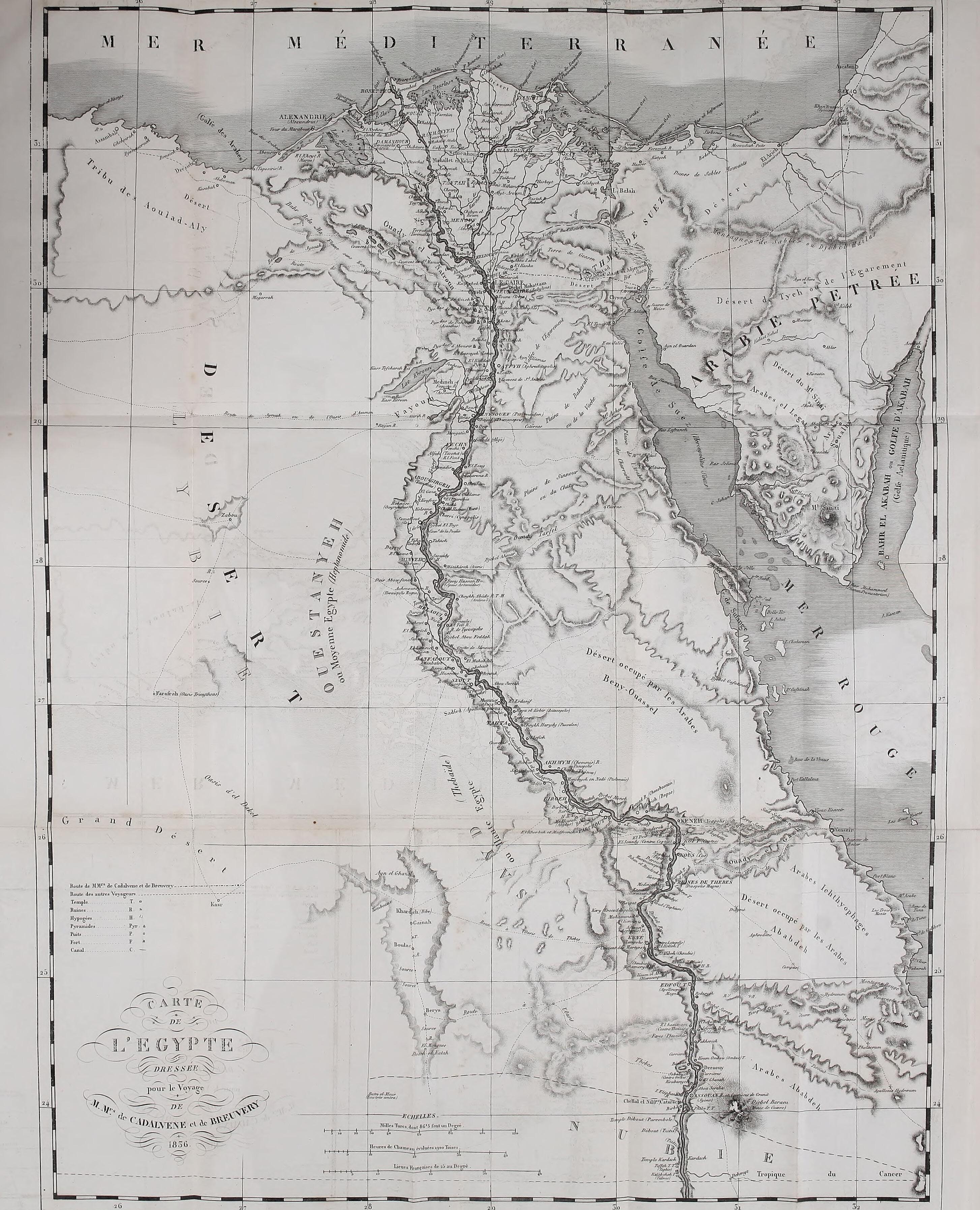
Their awestruck initial impression of Thebes was followed up with a thorough exploration of the region, which included trips to the temple at Karnak, the Ramesseum, the Valley of Kings, Medinet Habu, ElAssassif, and the city of Luxor. Their boat continued to follow the Nile down past the temples of Esna, Edfu, and Kom Ombo, and through Aswan and Elephantine into what is now Sudan. Their tour then passed through Khartoum, Gebel Adda, Wadi Halfa, and Dongola, to Kordofan. Kordofan was the furthest point along their travels down the Nile, whereupon they returned northwards, back to Saqqara.
De Breuvery and de Cadalvène’s comprehensive itinerary displays far more than a passing interest in Egypt and its ancient history. They make particular note of the state of antiquities in the sites they visit: "At these wells end one or more floors of galleries or side chambers; it is there that antiquities are most often found. It is extremely rare, among these tombs, to discover intact ones; but as the first plunderers sought only precious metals, one can still hope to find interesting objects after them." (De Breuvery and de Cadalvène, L’Égypte et La Nubie, pp. 312-13)
They interacted with contemporary Egyptologists, archaeologists, and other travellers. For instance, they met Robert Hay whilst at Beni Hasan. Hay was there drawing and transcribing the paintings on the Speos Artemidos, as he did for the coffin of Princess Sopdet-em-haawt.
Journey points of de Breuvery and de Cadalvène’s Travels in Egypt and Sudan.

"Mr. Hay, a wealthy English traveler and enthusiastic admirer of Egyptian architecture, was at Beny-Hassan when we arrived, busy carefully drawing the hieroglyphic paintings which decorate the speos of the mountain."
De Breuvery and de Cadalvène, L’Égypte et La Nubie, p. 431.


“The sarcophagus of the princess was painted in hues of the rising sun, as if she were cradled in light itself. The stars of Nut twinkled above her in silent vigil, a royal child ready to dance among the gods.”

The coffin has been conserved to preserve and protect the vunerable painted surface. It was during this process that old restoration was removed and the coffin was opened for the first time in c.200 years. The following report was written prior to, and during, restoration:
The Egyptian coffin is generally in good condition with some minor damages and old restoration.
The coffin is quite dirty, in some parts more than the others such as the crown of the head, shoulders and the top of the feet. There is a small retouching above and below the proper right eye, the primer and the pigment on the tip of the nose was missing, and on the center of the forehead. There were areas with flaking paint on top of the wig and some cracks on the sides where old retouches were found. Old retouches were found too on small areas on the chest decoration.
The sides of the pectoral had more losses than the rest of the sarcophagus. There is a small section on the proper right side toward the back with missing paint. There are numerous cracks on the surface including the face, the wig and the knees. A larger crack runs across the ankles. On the back pillar there is a large area of lost paint down to the wood surface towards the bottom.
The interior is covered with columns of inscription on the sides and white and yellow horizontal stripes with inscription from top to bottom. An area on the surface on the upper part and going to the proper left side was covered with dry mud as well as on numerous other smaller areas. Long cracks on the paint run from top to bottom on the two interior parts of the sarcophagus.

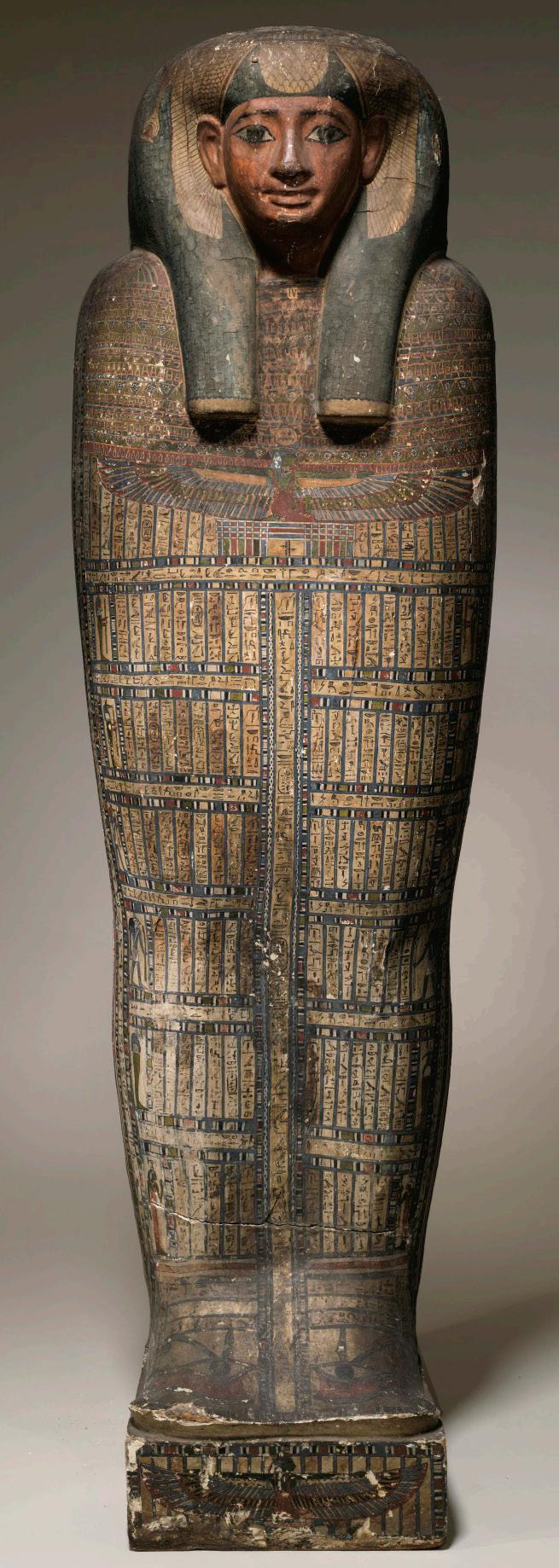
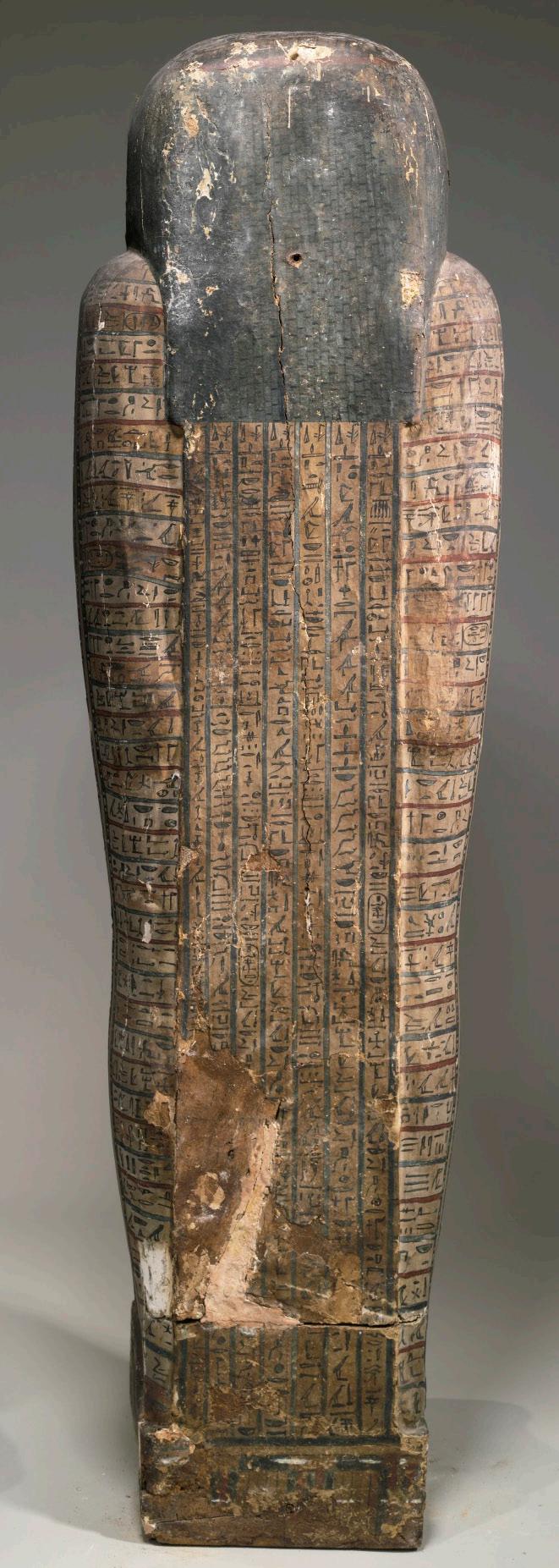
The whole surface of the coffin was manually cleaned to remove all the dirt and bring out the original colour. The missing tip of the nose was properly restored and retouched.
The old visible restorations on the face were cleaned and restored properly. The wig was cleaned to reveal the original blue color. The flaking paint areas on the top of the wig and the cracks on the sides were stabilised, filled in and restored.
The chest decoration and the columns with inscription on the body were cleaned, all the cracks and the loose gaps between the primed linen layer and the wood were stabilized and filled in. The top of the shoulders, the wig and the legs were particularly dirty and the original design was hardly visible. They were cleaned with great care to reveal the details and the original colour. The missing parts on the feet were restored.
The dirt on the inside of the coffin was cleaned away. The spots left from the mud incrustation were cleaned, and the cracks were stabilised, filled in, and restored.

The face was cleaned, with old restorations removed, the tip of the nose was properly restored and retouched.
All areas were cleaned, the top of the shoulders, the wig and the legs were particularly dirty.
The surface was cleaned to remove a buildup of dust and dirt most likely acquired in recent history
All cracks were consolidated and made structurally sound
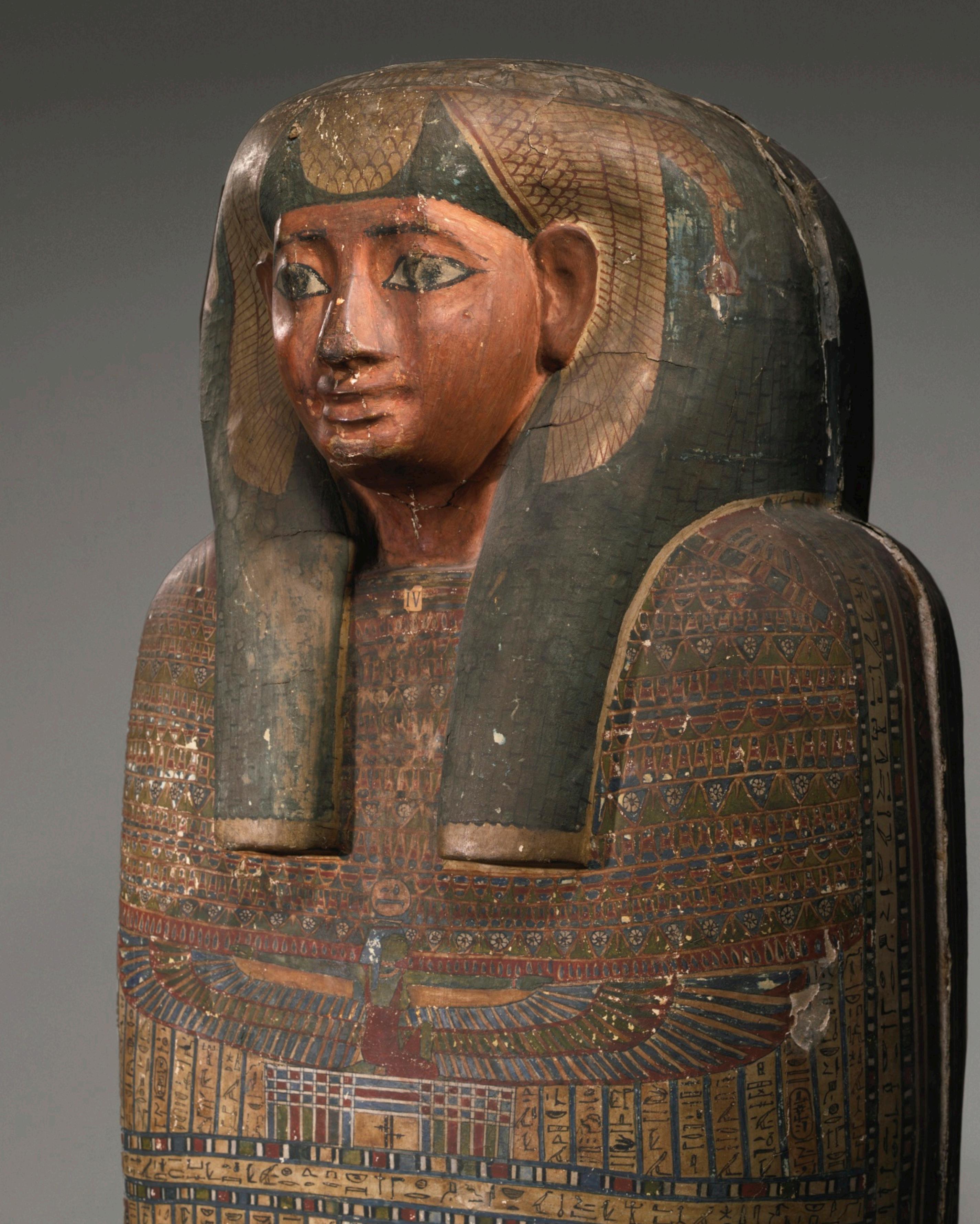

Other Known 25th and 26th Dynasty Wooden Painted Coffins
Coffin of Irthorru 26th Dynasty, Akhmim
L: 183.50 cm
The British Museum, London, EA20745

Coffin of Besenmut 26th Dynasty, Thebes
L: 190 cm
The British Museum, London, EA22940

Inner-coffin of Ankhesnefer
26th Dynasty, Thebes
L: 185 cm
The British Museum, London, EA6672

Inner-coffin of Irtyru 26th Dynasty, Memphis
L: 199.20 cm
The British Museum, London, EA6695
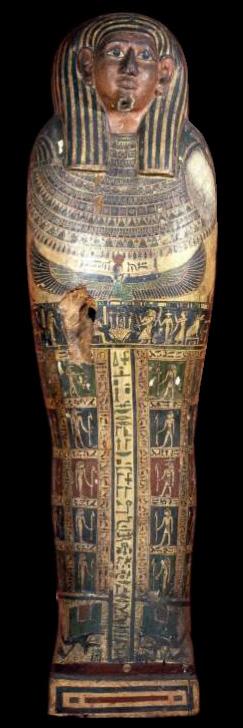
Coffin of Irethorrou 26th Dynasty, Egypt
L: 184 cm
Musée du Louvre, Paris, E 11296

Inner-coffin of Pesbes 26th Dynasty, Thebes
L: 183 cm
The British Museum, London, EA6671
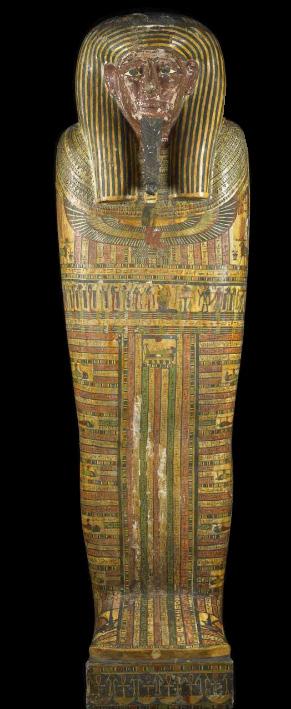
Inner Coffin Lid of Ditamunpaseneb
26th Dynasty, Thebes
L: 176.5 cm
World Museum, Liverpool, 24.11.81.5a(i)
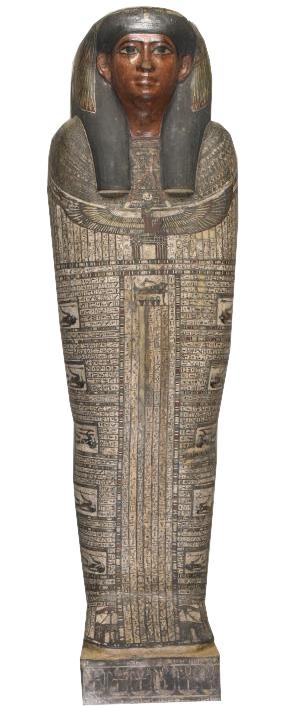
Coffin of Djeho 26th Dynasty/Ptolemaic, Akhmim
L: 182 cm
The British Museum, London, EA29776

Coffin of Tariout 26th Dynasty
L: 178 cm
Musée du Louvre, Paris, N 2580

Coffin of Isetirdis 26th Dynasty, Thebes
L: 180 cm
The Metropolitan Museum of Art, New York, 30.3.44a, b

Coffin of Thothirdes 664-525 B.C., 26th Dynasty, Saqqara
L: 177.8 cm
Brooklyn Museum, New York, 37.1521Ea-b

Coffin of Wedjarenes 26th Dynasty, Thebes
L: 190.1 cm
The Metropolitan Museum of Art, New York, O.C.22a, b
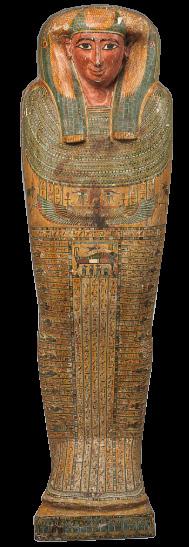
Coffin of Itnédjes 26th Dynasty, Egypt
L: 184 cm
Musée du Louvre, Paris, N 2564
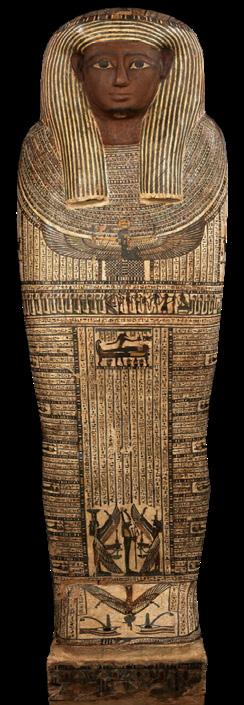
Coffin of the Noble Lady, Shep
25th-26th Dynasty, Egypt
L: 183 cm
The Metropolitan Museum of Art, New York, O.C.6b, c

Coffin of Kaahapy 25th-26th Dynasty, Egypt
L: 177 cm
Musée du Louvre, Paris, N 2566
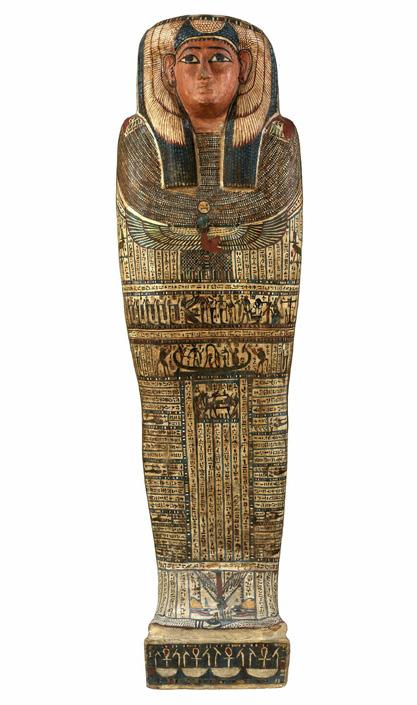
Coffin of Amunred Circa 715-525 B.C., 25th26th Dynasty, Egypt
L: 180.3 cm
North Carolina Museum of Art, Raleigh
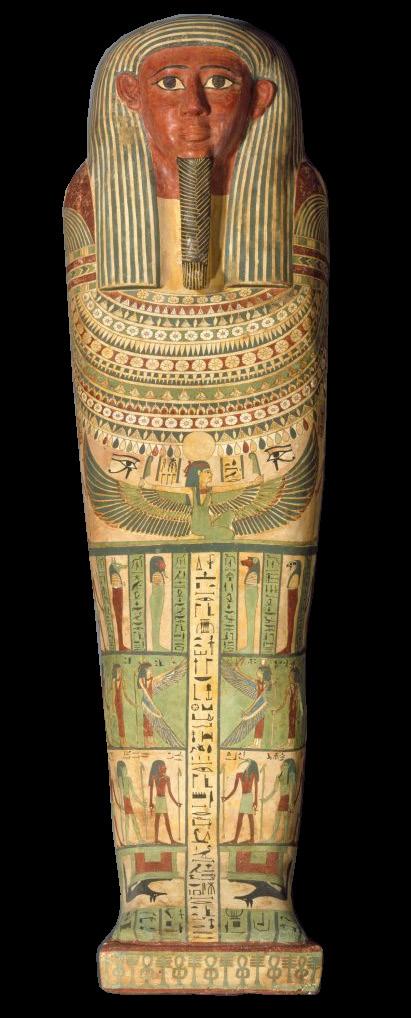
Coffin of Horsaiset 25th-26th Dynasty, Egypt
L: 178 cm
Musée du Louvre, Paris, E 13019
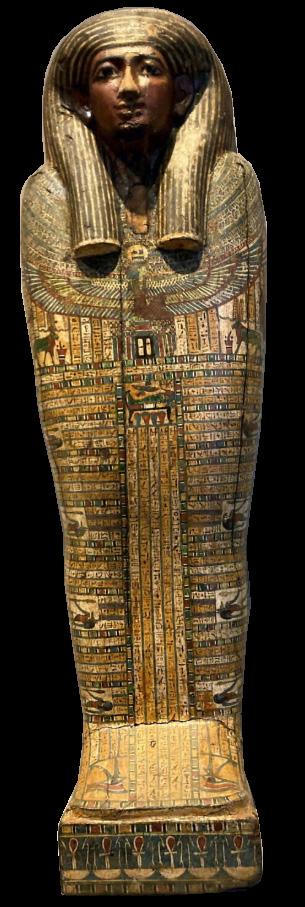
Coffin of Khampachemes 25th-26th Dynasty, Egypt
L: 176 cm
Musée du Louvre, Paris, E 13031

Coffin of Ptahirdis 25th-26th Dynasty, Thebes
L: 177 cm
Musée du Louvre, Paris, E 13024

Coffin of Kerpetchtiti 25th-26th Dynasty, Egypt
L: 176 cm
Musée du Louvre, Paris, E 3987

Coffin of Nesimenipet 25th-26th Dynasty, Egypt
L: 183 cm
Musée du Louvre, Paris, N 2568

Coffin of Hor 25th-26th Dynasty, Egypt
L: 180 cm
Musée du Louvre, Paris, N 2568

Coffin of Bekrenes 25th/26th Dynasty, Thebes
L: 148 cm
The British Museum, London, EA15654
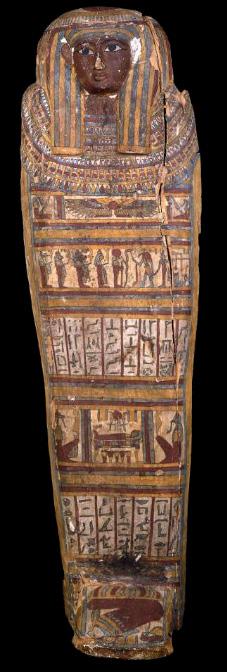
Mummy-case of Hor 25th Dynasty, Thebes
L: 179 cm
The British Museum, London, EA27735
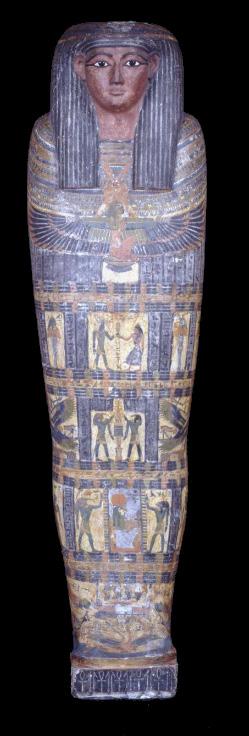
Coffin of Namenkhamen
25th Dynasty, Thebes
L: 184.5 cm
Museum of Fine Arts, Boston, 94.321

Inner-coffin of Djedmontuiufankh
25th Dynasty, Thebes
L: 191 cm
The British Museum, London, EA25256

Coffin set of Pakepu 25th Dynasty, Thebes
The Fitzwilliam Museum, Cambridge, E.2.1869

Coffin of Oudjarenes 25th Dynasty, Egypt
L: 189 cm
Musée du Louvre, Paris, N 2626

Coffin of Besenmout 25th Dynasty, Egypt
L: 186.3 cm
Musée du Louvre, Paris, E 10374
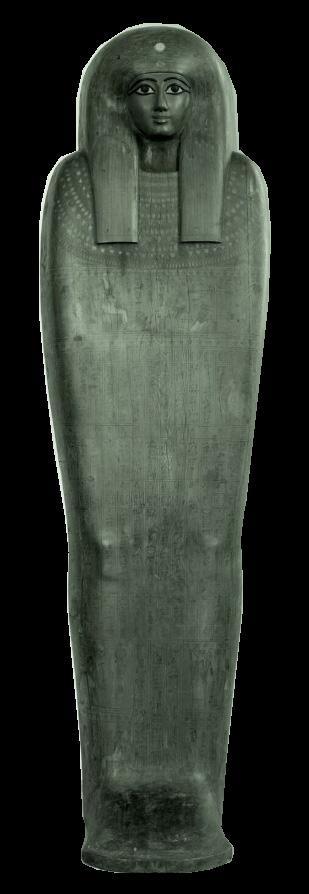
Inner Coffin of Nesmutaatneru
760-660 B.C., 25th Dynasty, Temple of Hatshepsut, Thebes
L: 169 cm
Museum of Fine Arts, Boston, 95.1407b

Coffin of Irou-bastetoudjantchaou
C. 725 B.C., 25th Dynasty, Temple of Hatshepsut, Thebes
L: 180 cm
Musée du Louvre, Paris, BMO 17

Coffin of Panououpeqer
C. 700 B.C., 25th Dynasty, West Thebes
L: 186 cm
Musée du Louvre, Paris, E 18846

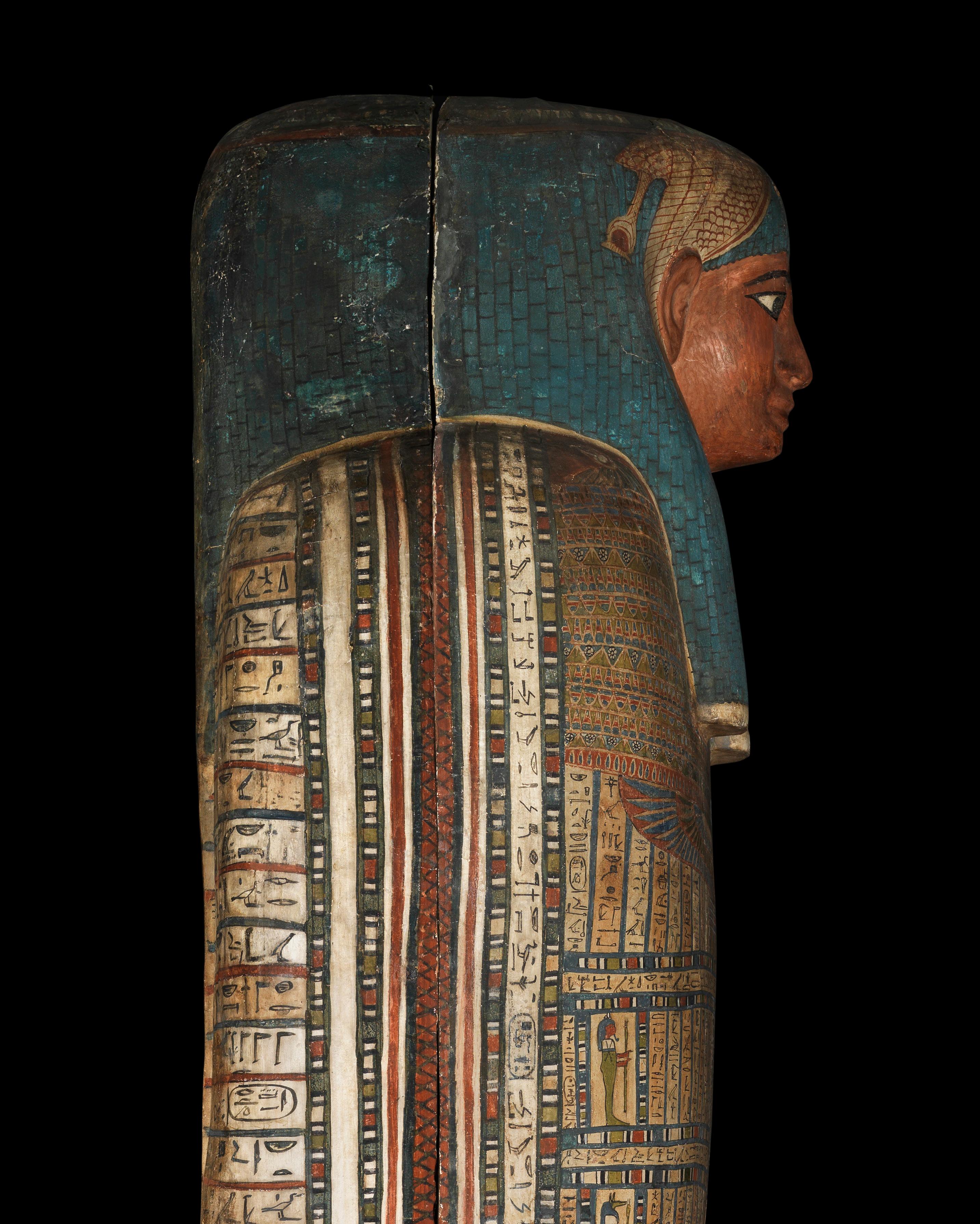
Exhibited
Museum of Fine Arts, Houston, U.S.A., 29 June 2018-30 May 2024 (Loan no. TR :402-2018).
Frieze Masters, London, October 2024
Making Egypt, The V&A, Cambridge Heath Rd, Bethnal Green, London, 15th February -22nd November 2025 (Loan ME 72)
Published
Erhart Graefe, ‘Eine Seite aus den Notizbüchern von Robert Hay’, in A. Eggebrecht and B. Schmitz (eds.), Festschrift Jürgen von Beckerath. Zum 70. Geburtstag am 19. Februar 1990, Hildesheimer Ägyptologische Beiträge, vol. 30 (Hildesheim, 1990), pp. 85-90, pl. 8a.
Jean-Marc Aubert, ‘On a retrouvé la fille du pharaon Pa Tatamon!’, Le Midi Libre (27 July 1992), p. 22.
Claus Jurman, ‘Die Namen des Rudjamun in der Kapelle des Osiris Hekadjet: Bemerkungen zu Titulaturen der 3. Zwischenzeit und dem Wadi Gasus-Graffito’, Göttinger Miszellen, 210 (2006), p. 71, H. Karl Jansen-Winkeln, Inschriften der Spätzeit Teil II. Die 22.-24. Dynastie (Wiesbaden, 2008).
Raphaële Meffre, ‘Une Princesse Héracléopolitaine de l’Époque Libyenne: Sopdet(em)haaout’, Revue d’Égyptologie, 60 (2009), pp. 215221.
Robert Morkot and Peter James, ‘Peftjauawybast, King of Nen-Nesut: Genealogy, Art History, and the Chronology of Late Libyan Egypt’, Antiguo Oriente, vol. 7 (Buenos Aires, 2009), p. 15.
Egyptian, Classical & Western Asiatic Antiquities, Sotheby’s, New York, 12 December 2013, Lot 15.
Raphaële Meffre, ‘Le cercueil intérieur de la princesse Sopdet-emhââout et la famille des rois Roudamon et Peftjaouâuybastet’, Monuments et mémoires de la Fondation Eugène Piot, 94 (2015), pp. 7-59.
Raphaële Meffre, ‘The Inner Coffin of Princess Sopdet-em-haawt’ in Sue H. D’Auria (ed.), Ancient Funerary Art from the EAI Collection, exhibition catalogue (Richmond, Virginia, 2016).


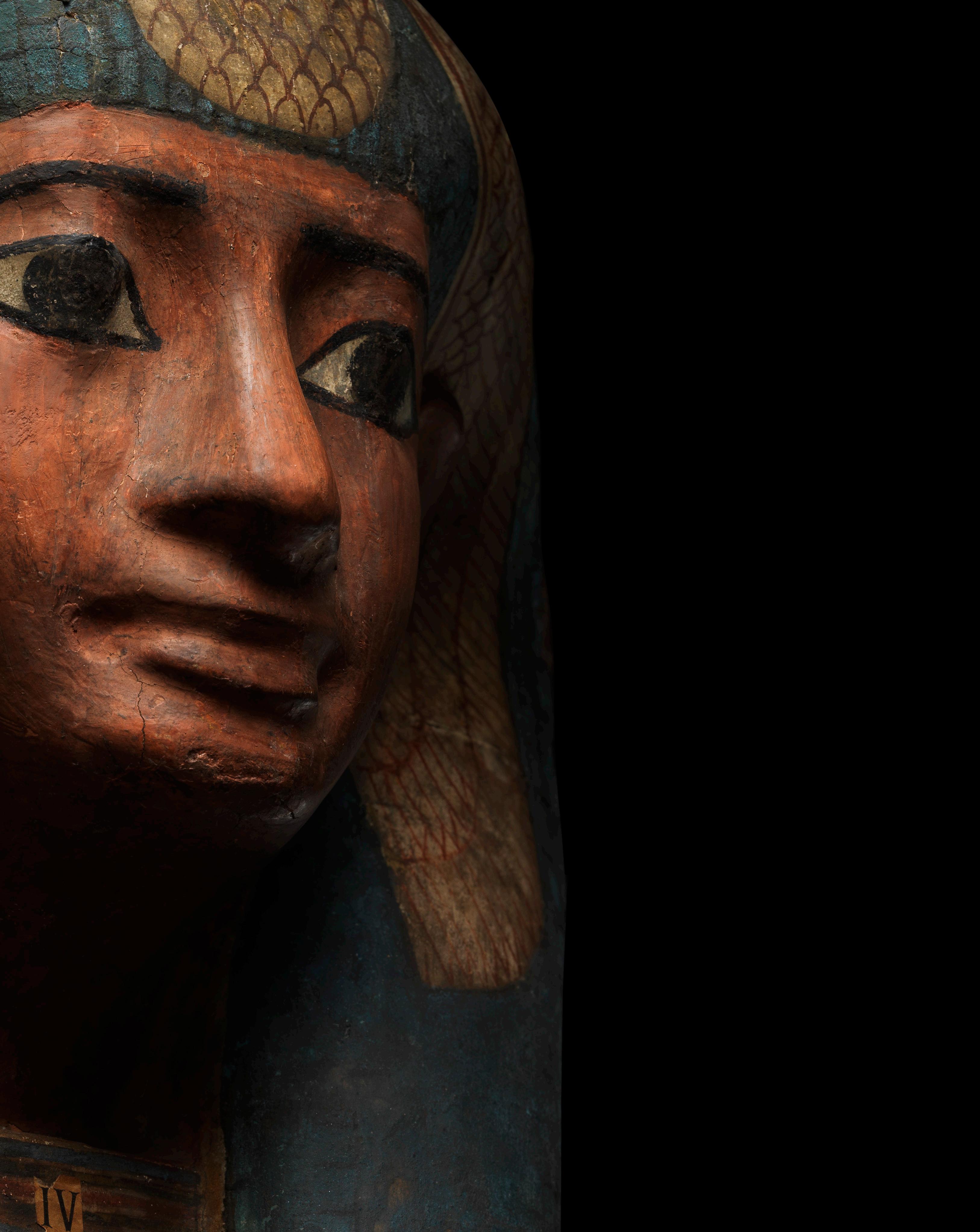

"The sarcophagus of the princess was adorned with intricate patterns of celestial flowers, as though even in death she would walk forever in the gardens of the afterlife, her spirit crowned with the soft fragrance of eternity."
Elizabeth Thomas, The Royal Necropoleis of Thebes (1966)
